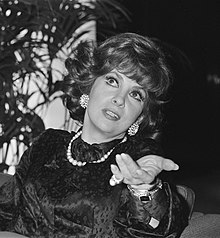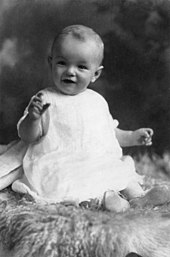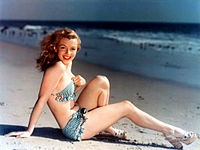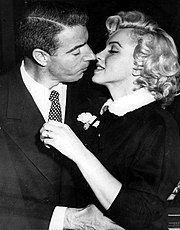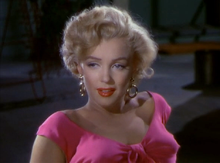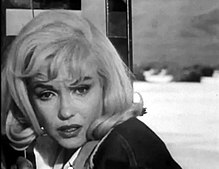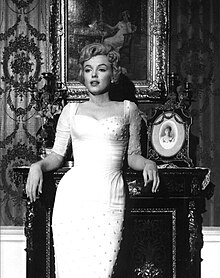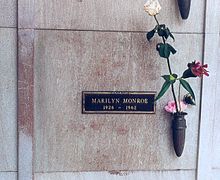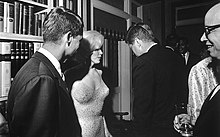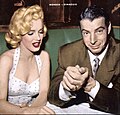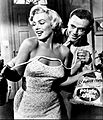
جينا لولو بريجيدا – Gina Lollobrigida
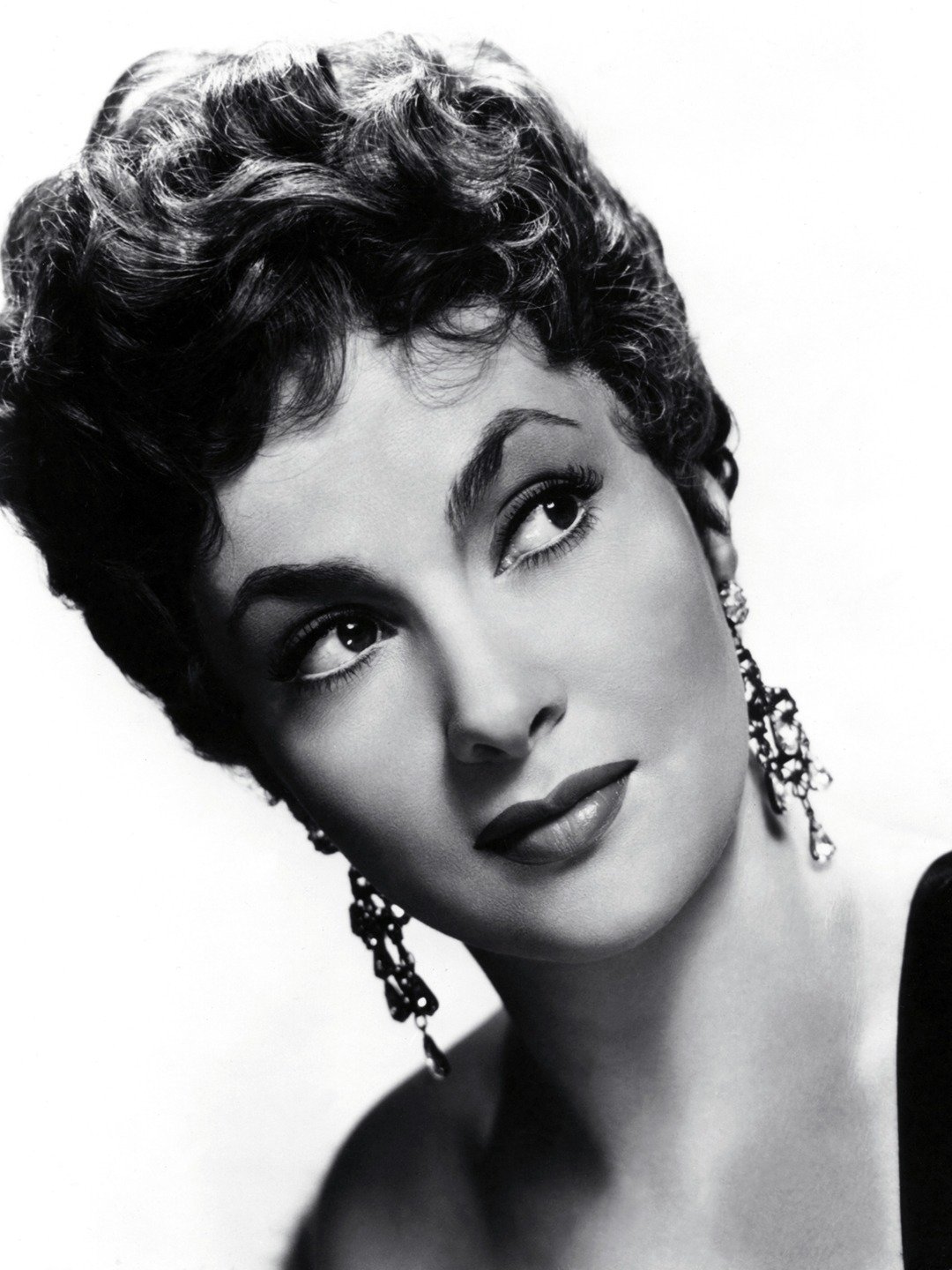
| جينا لولو بريجيدا | |
|---|---|
| (بالإيطالية: Gina Lollobrigida) | |
|
جينا لولو بريجيدا
|
|
|
|
|
| معلومات شخصية | |
| اسم الولادة | (بالإيطالية: Luigina Lollobrigida) |
| الميلاد | 4 يوليو 1927 Subiaco [1] |
| مواطنة | |
| لون الشعر | شعر بني |
| الحياة العملية | |
| المهنة | ممثلة، ومصورة، ونحّاتة، وصحفية، وممثلة أفلام |
| اللغات | الإيطالية |
| سنوات النشاط | 1946-1997 |
| الجوائز | |
|
نجمة على ممر الشهرة في هوليوود (2018)[2]
وسام جوقة الشرف من رتبة فارس (1992) نيشان استحقاق الجمهورية الإيطالية من رتبة ضابط أكبر (1987) نيشان الفنون والآداب من رتبة ضابط (1985) جائزة الغولدن غلوب |
|
| المواقع | |
| الموقع | الموقع الرسمي، والموقع الرسمي |
| IMDB | صفحتها على IMDB |
جينا لولو بريجيدا (بالإيطالية: Gina Lollobrigida) (وُلدت في 4 يوليو 1927) هي ممثلة ونحاتة ومصورة صحفية إيطالية
Gina Lollobrigida
Jump to navigationJump to search
|
|
This biography of a living person needs additional citations for verification. (August 2013) (Learn how and when to remove this template message)
|
|
Gina Lollobrigida
|
|
|---|---|

Lollobrigida in the 1960s
|
|
| Born |
Luigina Lollobrigida
4 July 1927 |
| Occupation | Actress, photojournalist |
| Years active | 1946–1997[citation needed] |
| Spouse(s) |
Milko Škofič
(m. 1949; div. 1971) |
| Children | Andrea Milko Škofič |
| Awards | Order of Merit of the Italian Republic, Legion of Honour, Ordre des Arts et des Lettres |
Luigina Lollobrigida (born 4 July 1927), known as Gina Lollobrigida,[a] is an Italian actress and since retirement photojournalist. She was one of the highest-profile European actresses of the 1950s and early 1960s, a period in which she was an international sex symbol.
As her film career slowed, she established a second career as a photojournalist. In the 1970s, she achieved a scoop by gaining access to Fidel Castro for an exclusive interview.
She has continued as an active supporter of Italian and Italian American causes, particularly the National Italian American Foundation (NIAF). In 2008, she received the NIAF Lifetime Achievement Award at the Foundation’s Anniversary Gala.[1][2] In 2013, she sold her jewelry collection, and donated the nearly $5 million from the sale to benefit stem cell therapy research.[3]
Youth
Born Luigina Lollobrigida in Subiaco, Italy, she is one of four daughters of a furniture manufacturer and his wife. Her sisters are Giuliana (born 1924), Maria (born 1929) and Fernanda (1930–2011). In her youth, Lollobrigida did some modelling and participated successfully in several beauty contests. At around this time, she began appearing in Italian films in minor roles.
In 1945, at age 18, she played a part in the comedy Santarellina by Eduardo Scarpetta at the Teatro della Concordia of Monte Castello di Vibio.[citation needed] (It is the smallest theatre all’italiana in the world.)[4]
In 1947, Lollobrigida entered the Miss Italia pageant and came in third place, giving her national exposure.[citation needed]
Acting career
Cinema
In 1950, Howard Hughes signed Lollobrigida on a preliminary seven-year contract to make three pictures a year.[5] She refused the final terms of the contract, preferring to remain in Europe and Hughes suspended her.[5] Despite selling RKO Pictures in 1955, Hughes retained Lollobrigida’s contract.[5] The dispute prevented her from working in American movies filmed in the US until 1959, though not from working in American productions shot in Europe, although Hughes often threatened legal action against the producers.[5]
Her performance in Bread, Love and Dreams (Pane, amore e fantasia, 1953) led to it becoming a box-office success[5] and her receiving a BAFTA nomination, and won a Nastro d’Argento award. Lollobrigida also appeared in The Wayward Wife (1953) and in Woman of Rome (1954). These were three of her most renowned Italian films, but she worked also in the French industry on such films as Fearless Little Soldier (Fanfan la Tulipe, 1952), Beauties of the Night (Les Belles de nuit, also 1952) and Le Grand Jeu (1954).
Her first widely seen English language film was Beat the Devil (1953), a film which was shot in Italy. In this film, directed by John Huston, she played the wife of Humphrey Bogart, with Jennifer Jones as her rival. She then took part in the Italian-American production Crossed Swords (1954), co-starring with Errol Flynn. Her appearance in The World’s Most Beautiful Woman (also known as Beautiful But Dangerous, 1955) led to her receiving the first David di Donatello for Best Actress award; in this film she interpreted the Italian soprano Lina Cavalieri, singing some arias from Tosca with her own voice. She had the principal female lead in the circus drama Trapeze (1956) directed by Carol Reed co-starring with Burt Lancaster and Tony Curtis and in The Hunchback of Notre Dame (1956), appeared as Esmeralda with Anthony Quinn as Quasimodo. The film was directed by Jean Delannoy.

Gina Lollobrigida in Solomon and Sheba (1959)
In 1959, she appeared in the French movie The Law, alongside Yves Montand and Marcello Mastroianni; then, she co-starred with Frank Sinatra in Never So Few (1959) and with Yul Brynner in Solomon and Sheba (also 1959). The latter was the last film directed by King Vidor, and features an almost unique orgy scene in Hollywood motion pictures of that era; furthermore, Brynner was chosen to substitute for Tyrone Power, who died before the shots were completed.
In the romantic comedy Come September (1961), Lollobrigida had a leading role along with Rock Hudson, Sandra Dee and Bobby Darin. It was a film for which she won a Golden Globe Award. She appeared, also in 1961, with Ernest Borgnine and Anthony Franciosa in the drama Go Naked in the World.

Lollobrigida as The Fairy with Turquoise Hair in the TV series The Adventures of Pinocchio (1972)
Jean Delannoy then directed her again, this time in Venere Imperiale (1962). She co-starred with Stephen Boyd and she received Nastro d’Argento and David di Donatello awards. She co-starred with Sean Connery in the thriller Woman of Straw (1964), with Rock Hudson again in Strange Bedfellows (1965) and appeared with Alec Guinness in Hotel Paradiso (1966).
She starred in Buona Sera, Mrs. Campbell (1968) with Shelley Winters, Phil Silvers, Peter Lawford and Telly Savalas. For this role, she was nominated for a Golden Globe Award and won a third David di Donatello award. Lollobrigida co-starred with Bob Hope in the comedy The Private Navy of Sgt. O’Farrell and also accompanied Hope on his visits to military troops overseas.

Gina Lollobrigida at the 1991 Cannes Film Festival
By the 1970s, her film career had slowed down. She appeared in King, Queen, Knave, co-starring with David Niven, and in a few other poorly received productions in the early part of the decade. In 1973, she was a member of the jury at the 8th Moscow International Film Festival.[6] However, during her career, she refused many proposals: in Lady L, with Tony Curtis, and directed by George Cukor, initially, all suspended because the contrasts between her and Cukor; the leading role went then to Sophia Loren; in Five Branded Women, directed by Martin Ritt, and whose the leading role went then to Silvana Mangano; in The Lady Without Camelias, directed by Michelangelo Antonioni, whose the leading role went finally to Lucia Bosè. She revealed that was a great regret having refused a supporting role in La Dolce Vita, wanted by Federico Fellini; about this, she added that, at the time, scripts arrived too much and her husband accidentally hid that one.
Television
In the mid-1980s, she starred in the television series Falcon Crest as Francesca Gioberti, a role originally written for Sophia Loren, who had turned it down. For that role she received a third Golden Globe nomination. She also had a supporting role in the 1985 television miniseries Deceptions, co-starring with Stefanie Powers. The following year she appeared as guest star in the TV series The Love Boat.[citation needed]
Judging
In 1986, she was invited to head the jury at the 36th Berlin International Film Festival, which awarded the Golden Bear to Reinhard Hauff‘s film Stammheim. She said the decision was made for political reasons.[7]
In the 1990s, she made a few minor French film appearances and continued to participate and attend international film festivals.[citation needed]
Photojournalism
By the end of the 1970s, Lollobrigida had embarked on what she developed as a successful second career as a photographic journalist. She photographed, among others, Paul Newman, Salvador Dalí, Henry Kissinger, David Cassidy, Audrey Hepburn, Ella Fitzgerald, and the German national football team. She even managed to obtain an exclusive interview with Fidel Castro, leader of Communist Cuba. In 1973, a collection of her work was published under the title Italia Mia.[citation needed]
Personal life
In 1949, Lollobrigida married a Slovenian physician, Milko Škofič. They had one child, Andrea Milko[8] (Milko Škofič, Jr.), born on 28 July 1957.[9] Škofič gave up the practice of medicine to become her manager.[10] In 1960, Lollobrigida moved from her native Italy to Toronto, Canada, with Škofič and their child.[11] They divorced in 1971.[12]
In January 1968, she also had a one-night extramarital affair with Christiaan Barnard, a South African doctor and pioneer in heart transplant surgery.[13][14]

Gina Lollobrigida and her son Andrea Milko in Rome in 1962 at the Piazza Navona Christmas market
In October 2006, at age 79, she announced to Spain’s ¡Hola! magazine her engagement to a 45-year-old Spanish businessman, Javier Rigau y Rafols. They had met at a party in Monte Carlo in 1984 and had since become companions.[15] The engagement was called off on 6 December 2006, reportedly because of the strain of intense media interest.[16]
In January 2013, she started legal action against Javier Rigau y Rafols, claiming that her ex-boyfriend had staged a secret ceremony in which he “married” an imposter pretending to be her at a registry office in Barcelona. She said he intended to lay claim to her estate after her death. Lollobrigida accused Rigau of fraud, saying that he had earlier obtained the legal right to act on her behalf with a power of attorney, and carried out the plot to get extra power. “A while ago he convinced me to give him my power of attorney. He needed it for some legal affairs. But instead I fear that he took advantage of the fact that I don’t understand Spanish … Who knows what he had me sign.”[17] In March 2017 she lost her court action but has said she will appeal.[18]
Now retired, Lollobrigida has not made a film since 1997. She told PARADE in April 2000: “I studied painting and sculpting at school and became an actress by mistake … I’ve had many lovers and still have romances. I am very spoiled. All my life, I’ve had too many admirers.” She now divides her time between her house on Via Appia Antica in Rome and a villa in Monte Carlo.[17] Since 2009 Lollobrigida has not allowed visitors to her home.[17]
In 2013, Lollobrigida sold her jewelry collection through Sotheby’s. She donated nearly $5 million to benefit stem cell therapy.[19]
Lollobrigida has a habit of referring to herself in the third person.[20][21][22]
Awards and nominations
Lollobrigida has won three David di Donatello, two Nastro d’Argento, and six Bambi Awards. She was nominated three times for the Golden Globe and won one in 1961 as World Film Favourite – Female. She was nominated once for a BAFTA award.
In 1985, she was nominated as an officer of France’s Ordre des Arts et des Lettres by Jack Lang, for her achievements in photography and sculpture.
She was awarded the Légion d’honneur by François Mitterrand.[23]
On 16 October 1999, Gina Lollobrigida was nominated Goodwill Ambassador of the UN Food and Agriculture Organization.[24]
On 1 February 2018, Lollobrigida received a star on the Hollywood Walk of Fame.[25]
Books
- Italia mia, 1973, a collection of photographs across Italy
- The Philippines, 1976, a collection of photographs across the Philippines
- Wonder of Innocence, 1994, a book of photographs
- Sculptures, 2003
Filmography
Cinema
| Year | Film | Role | Notes |
|---|---|---|---|
| 1946 | Lucia di Lammermoor | ||
| 1946 | This Wine of Love | ||
| 1946 | Black Eagle | Girl at party | |
| 1947 | When Love Calls | ||
| 1947 | Pagliacci | Nedda | |
| 1947 | Flesh Will Surrender | Dancer | |
| 1947 | Vendetta nel sole | Young girl | |
| 1948 | Mad About Opera | Dora | |
| 1949 | Alarm Bells | Agostina | |
| 1949 | The Bride Can’t Wait | Donata Venturi | |
| 1949 | The White Line | Donata Sebastian | |
| 1950 | A Dog’s Life | Rita Buton | |
| 1950 | Miss Italy | Lisetta Minneci | |
| 1950 | Alina | Alina | |
| 1951 | A Tale of Five Cities | Maria Severini | |
| 1951 | The Young Caruso | Stella | |
| 1951 | Four Ways Out | Daniela | |
| 1951 | Love I Haven’t… But… But | Gina | |
| 1951 | Attention! Bandits! | Anna | |
| 1952 | Wife For a Night (Moglie per una notte) | Ottavia | |
| 1952 | Times Gone By | Mariantonia Desiderio | |
| 1952 | Fanfan la Tulipe | Adeline La Franchise | |
| 1952 | Beauties of the Night | Leila, Cashier | |
| 1953 | The Wayward Wife | Gemma Vagnuzzi | |
| 1953 | Bread, Love and Dreams | Maria De Ritis | Nominated – BAFTA Award for Best Foreign Actress Nastro d’Argento for Best Actress |
| 1953 | Le infedeli | Lulla Possenti | |
| 1953 | Beat the Devil | Maria Dannreuther | UK-USA-Italy |
| 1954 | Woman of Rome | Adriana | |
| 1954 | Bread, Love and Jealousy | Maria De Ritis | |
| 1954 | Crossed Swords | Francesca | |
| 1954 | Le Grand Jeu | Sylvia Sorrego, Helena Ricci | |
| 1955 | The World’s Most Beautiful Woman | Lina Cavalieri | David di Donatello for Best Actress |
| 1956 | Trapeze | Lola | |
| 1956 | The Hunchback of Notre Dame | Esmeralda | |
| 1958 | Anna of Brooklyn | Anna | |
| 1959 | The Law | Marietta | |
| 1959 | Never So Few | Carla Vesari | |
| 1959 | Solomon and Sheba | Queen of Sheba | |
| 1961 | Go Naked in the World | Giulietta Cameron | |
| 1961 | Come September | Lisa Helena Fellini | Golden Globe Henrietta Award, World Film Favorite – Female |
| 1962 | Lykke og krone (documentary) | ||
| 1962 | La bellezza di Ippolita | Ippolita | |
| 1963 | Venere Imperiale | Paulette Bonaparte | David di Donatello for Best Actress Nastro d’Argento for Best Actress |
| 1963 | Mad Sea | Margherita | |
| 1964 | Woman of Straw | Maria Marcello | |
| 1965 | Me, Me, Me… and the Others | Titta | |
| 1965 | Le Bambole (The Dolls) | Beatrice | |
| 1965 | Strange Bedfellows | Toni Vincente | |
| 1965 | The Love Goddesses (documentary) | ||
| 1966 | Pleasant Nights | Domicilla | |
| 1966 | The Sultans | Liza Bortoli | |
| 1966 | Hotel Paradiso | Marcelle Cotte | |
| 1967 | Cervantes | Giulia Toffolo | |
| 1968 | Stuntman | Evelyne Lake | |
| 1968 | Death Laid an Egg | Anna | |
| 1968 | The Private Navy of Sgt. O’Farrell | Maria | |
| 1968 | Buona Sera, Mrs. Campbell | Carla Campbell | Nominated – Golden Globe Award for Best Actress – Motion Picture Musical or Comedy David di Donatello for Best Actress |
| 1969 | That Splendid November | Cettina | |
| 1971 | Bad Man’s River | Alicia King | |
| 1972 | King, Queen, Knave | Martha Dreyer | |
| 1973 | No encontre rosas para mi madre | ||
| 1983 | Wandering Stars (documentary) | ||
| 1995 | Les cent et une nuits de Simon Cinéma | L’épouse médium du professeur Bébel | |
| 1997 | XXL | Gaby | |
| 2011 | Box Office 3D: The Filmest of Films | Herself | (cameo appearance) |
Television
| Year | Film | Role | Notes |
|---|---|---|---|
| 1958 | Portrait of Gina (documentary) | Lost from 1958 until 1986, when it turned up in a storage unit of the Ritz Hotel, Paris, where director Orson Welles had left the only copy. Upon rediscovery, it was screened once at the 1986 Venice Film Festival, and once on German television, before Lollobrigida (who had seen the Venice screening) took legal action to have it banned, due to its unflattering portrayal of her as an ambitious young star.[26] | |
| 1972 | The Adventures of Pinocchio | The Fairy with Turquoise Hair | |
| 1984 | Falcon Crest | Francesca Gioberti | 5 episodes Nominated – Golden Globe Award for Best Supporting Actress – Series, Miniseries or Television Film |
| 1985 | Deceptions | ||
| 1986 | The Love Boat | ||
| 1988 | Woman of Rome | Adriana’s mother | television remake |
| 1996 | Una donna in fuga |
Other
- English rock band Cardiacs included a song titled ‘Gina Lollobrigida’ on their 1984 album The Seaside.[27]

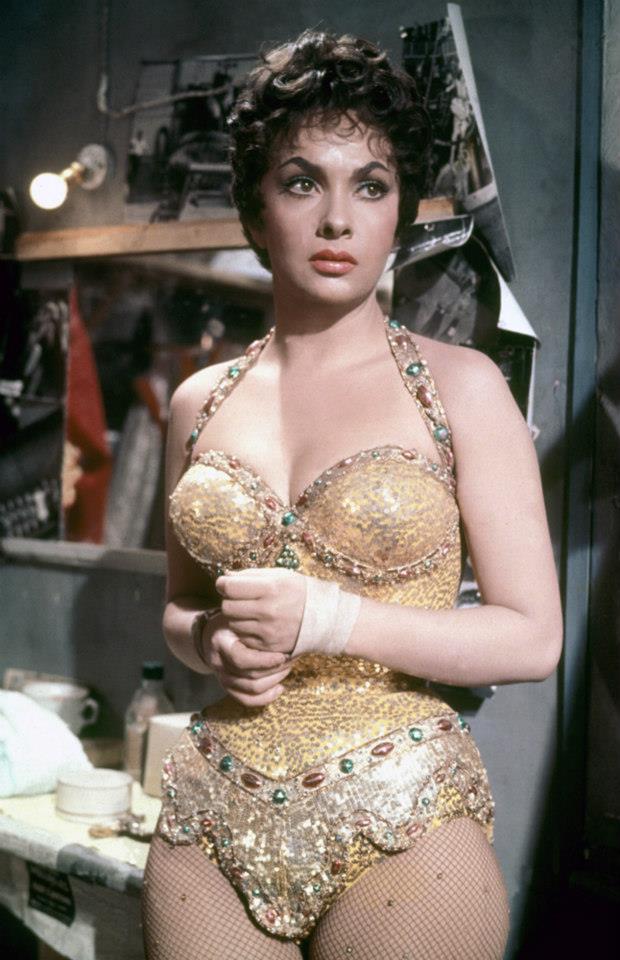
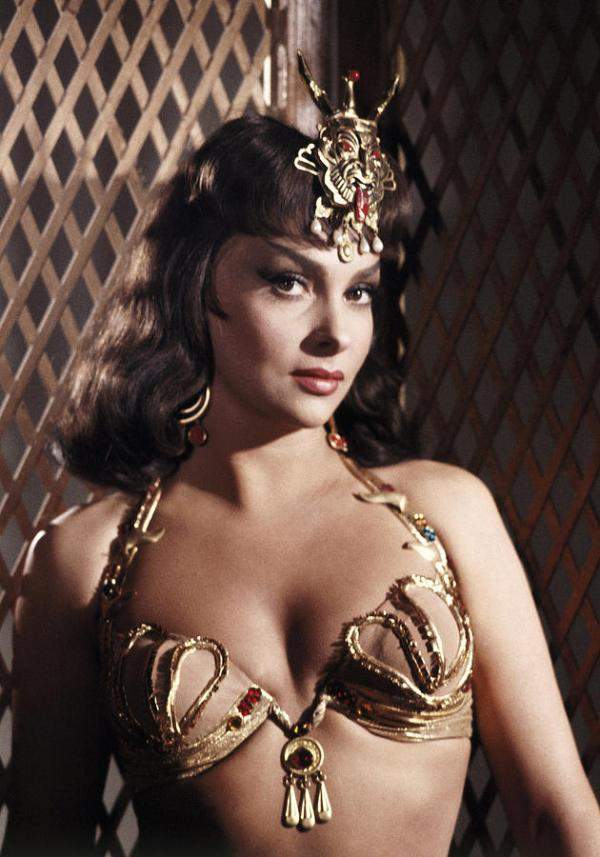
ـــــــــــــــــــــــــــــــــــــــــــ
Marilyn Monroe
Jump to navigationJump to search
|
Marilyn Monroe
|
|
|---|---|

Monroe in November 1953
|
|
| Born |
Norma Jeane Mortenson
June 1, 1926 Los Angeles, California, U.S.
|
| Died | August 4, 1962 (aged 36)
Los Angeles, California, U.S.
|
| Cause of death | Barbiturate overdose |
| Resting place | Westwood Village Memorial Park Cemetery |
| Other names | Norma Jeane Baker |
| Occupation |
|
| Years active | 1945–1962 |
| Spouse(s) |
James Dougherty
(m. 1942; div. 1946) |
| Website | marilynmonroe |
| Signature | |
Marilyn Monroe (/ˈmærɪlɪn mənˈroʊ/; born Norma Jeane Mortenson; June 1, 1926 – August 4, 1962) was an American actress, model, and singer. Famous for playing comedic “blonde bombshell” characters, she became one of the most popular sex symbols of the 1950s and early 1960s and was emblematic of the era’s changing attitudes towards sexuality. She was a top-billed actress for only a decade, but her films grossed $200 million (equivalent to $2 billion in 2019) by the time of her death in 1962.[1] Long after her death, she has continued to be a major icon of pop culture.[2]
Born and raised in Los Angeles, Monroe spent most of her childhood in foster homes and an orphanage and married at age 16. She was working in a factory as part of the war effort during World War II when she met a photographer from the First Motion Picture Unit and began a successful pin-up modeling career. The work led to short-lived film contracts with 20th Century Fox and Columbia Pictures. After a series of minor film roles, she signed a new contract with Fox in late 1950. Over the next two years, she became a popular actress with roles in several comedies, including As Young as You Feel and Monkey Business, and in the dramas Clash by Night and Don’t Bother to Knock. She faced a scandal when it was revealed that she had posed for nude photos before she became a star, but the story did not damage her career and instead resulted in increased interest in her films.
By 1953, Monroe was one of the most marketable Hollywood stars; she had leading roles in the film noir Niagara, which focused on her sex appeal, and the comedies Gentlemen Prefer Blondes and How to Marry a Millionaire, which established her star image as a “dumb blonde”. The same year, her nude images were used as the centerfold and on the cover of the first issue of Playboy. She played a significant role in the creation and management of her public image throughout her career, but she was disappointed when she was typecast and underpaid by the studio. She was briefly suspended in early 1954 for refusing a film project but returned to star in The Seven Year Itch (1955), one of the biggest box office successes of her career.
When the studio was still reluctant to change Monroe’s contract, she founded her own film production company in 1954. She dedicated 1955 to building the company and began studying method acting at the Actors Studio. In late 1955, Fox awarded her a new contract, which gave her more control and a larger salary. Her subsequent roles included a critically acclaimed performance in Bus Stop (1956) and her first independent production in The Prince and the Showgirl (1957). She won a Golden Globe for Best Actress for her work in Some Like It Hot (1959), a critical and commercial success. Her last completed film was the drama The Misfits (1961).
Monroe’s troubled private life received much attention. She struggled with addiction, depression, and anxiety. Her marriages to retired baseball star Joe DiMaggio and to playwright Arthur Miller were highly publicized, and both ended in divorce. On August 4, 1962, she died at age 36 from an overdose of barbiturates at her home in Los Angeles. Her death was ruled a probable suicide, although several conspiracy theories have been proposed in the decades following her death.
Life and career
1926–1943: Childhood and first marriage
Monroe was born Norma Jeane Mortenson at the Los Angeles County Hospital in Los Angeles, California, on June 1, 1926.[3] Her mother, Gladys Pearl Baker (née Monroe, 1902–1984), was from a poor Midwestern family who had migrated to California at the turn of the century.[4] At the age of 15, Gladys married John Newton Baker, an abusive man nine years her senior, and had two children by him named Robert (1917–1933)[5] and Berniece (b. 1919).[6] She successfully filed for divorce and sole custody in 1923, but Baker kidnapped the children soon after and moved with them to his native Kentucky.[7] Monroe was not told that she had a sister until she was 12, and met her sister for the first time as an adult.[8] Following the divorce, Gladys worked as a film negative cutter at Consolidated Film Industries.[9] In 1924, Gladys married Martin Edward Mortensen, but they separated only some months later and divorced in 1928.[9] The identity of Monroe’s father is unknown, and she most often used Baker as her surname.[10][a]
—Monroe in an interview for Life in 1962
Although Gladys was mentally and financially unprepared for a child, Monroe’s early childhood was stable and happy.[15] Gladys placed her daughter with evangelical Christian foster parents Albert and Ida Bolender in the rural town of Hawthorne; she also lived there for the first six months, until she was forced to move back to the city due to work.[16] She then began visiting her daughter on weekends.[15] In the summer of 1933, Gladys bought a small house in Hollywood with a loan from the Home Owners’ Loan Corporation and moved seven-year-old Monroe in with her.[17] They shared the house with lodgers, actors George and Maude Atkinson and their daughter, Nellie.[18] In January 1934, Gladys had a mental breakdown and was diagnosed with paranoid schizophrenia.[19] After several months in a rest home, she was committed to the Metropolitan State Hospital.[20] She spent the rest of her life in and out of hospitals and was rarely in contact with Monroe.[21] Monroe became a ward of the state, and her mother’s friend, Grace Goddard, took responsibility over her and her mother’s affairs.[22]
In the next four years, Monroe’s living situation changed often. For the first 16 months, she continued living with the Atkinsons, and was sexually abused during this time.[23][b] Always a shy girl, she now also developed a stutter and became withdrawn.[29] In the summer of 1935, she briefly stayed with Grace and her husband Erwin “Doc” Goddard and two other families,[30] and in September, Grace placed her in the Los Angeles Orphans Home.[31] The orphanage was “a model institution” and was described in positive terms by her peers, but Monroe felt abandoned.[32] Encouraged by the orphanage staff who thought that Monroe would be happier living in a family, Grace became her legal guardian in 1936, but did not take her out of the orphanage until the summer of 1937.[33] Monroe’s second stay with the Goddards lasted only a few months because Doc molested her;[34] she then lived brief periods with her relatives and Grace’s friends and relatives in Los Angeles and Compton.[35]
Monroe found a more permanent home in September 1938, when she began living with Grace’s aunt, Ana Lower, in Sawtelle.[36] She was enrolled in Emerson Junior High School and went to weekly Christian Science services with Lower.[37] Monroe was otherwise a mediocre student, but excelled in writing and contributed to the school newspaper.[38] Due to the elderly Lower’s health problems, Monroe returned to live with the Goddards in Van Nuys in around early 1941.[39] The same year, she began attending Van Nuys High School.[40] In 1942, the company that employed Doc Goddard relocated him to West Virginia.[41] California child protection laws prevented the Goddards from taking Monroe out of state, and she faced having to return to the orphanage.[42] As a solution, she married their neighbors’ 21-year-old son, factory worker James Dougherty, on June 19, 1942, just after her 16th birthday.[43] Monroe subsequently dropped out of high school and became a housewife. She found herself and Dougherty mismatched and later stated that she was “dying of boredom” during the marriage.[44] In 1943, Dougherty enlisted in the Merchant Marine and was stationed on Santa Catalina Island, where Monroe moved with him.[45]
1944–1949: Modeling and first film roles

Photo by Conover of Monroe at the Radioplane Company in mid-1944
In April 1944, Dougherty was shipped out to the Pacific, and he would remain there for most of the next two years.[45] Monroe moved in with his parents and began a job at the Radioplane Company, a munitions factory in Van Nuys.[45] In late 1944, she met photographer David Conover, who had been sent by the U.S. Army Air Forces‘ First Motion Picture Unit to the factory to shoot morale-boosting pictures of female workers.[46] Although none of her pictures were used, she quit working at the factory in January 1945 and began modeling for Conover and his friends.[47][48] Defying her deployed husband, she moved on her own and signed a contract with the Blue Book Model Agency in August 1945.[49]
As a model, Monroe occasionally used the name Jean Norman.[50] She straightened her curly brunette hair and dyed it blonde to make herself more employable.[50] Her figure was deemed more suitable for pin-up than fashion modeling, and she was featured mostly in advertisements and men’s magazines.[51] According to Emmeline Snively, the agency’s owner, Monroe was one of its most ambitious and hard-working models; by early 1946, she had appeared on 33 magazine covers for publications such as Pageant, U.S. Camera, Laff, and Peek.[52]
Through Snively, Monroe signed a contract with an acting agency in June 1946.[53] After an unsuccessful interview at Paramount Pictures, she was given a screen-test by Ben Lyon, a 20th Century-Fox executive. Head executive Darryl F. Zanuck was unenthusiastic about it,[54] but he gave her a standard six-month contract to avoid her being signed by rival studio RKO Pictures.[c] Monroe’s contract began in August 1946, and she and Lyon selected the stage name “Marilyn Monroe”.[56] The first name was picked by Lyon, who was reminded of Broadway star Marilyn Miller; the last was Monroe’s mother’s maiden name.[57] In September 1946, she divorced Dougherty, who was against her having a career.[58]
Monroe had no film roles during the first six months and instead dedicated her days to acting, singing and dancing classes.[59] Eager to learn more about the film industry, she also spent time at the studio lot to observe others working and to promote herself.[60] Her contract was renewed in February 1947, and she was given her first film roles, bit parts in Dangerous Years (1947) and Scudda Hoo! Scudda Hay! (1948).[61][d] The studio also enrolled her in the Actors’ Laboratory Theatre, an acting school teaching the techniques of the Group Theatre; she later stated that it was “my first taste of what real acting in a real drama could be, and I was hooked”.[63] Despite her enthusiasm, her teachers thought her too shy and insecure to have a future in acting, and Fox did not renew Monroe’s contract in August 1947.[64] She returned to modeling while also doing occasional odd jobs at film studios, such as working as a dancing “pacer” behind the scenes at musical sets.[64]
Monroe was determined to make it as an actress, and continued studying at the Actors’ Lab. In October 1947, she appeared as a blonde vamp in the play Glamour Preferred at the Bliss-Hayden Theater, but it ended after only a few performances.[65] To promote herself, she frequented producers’ offices, befriended gossip columnist Sidney Skolsky, and entertained influential male guests at studio functions, a practice she had begun at Fox.[66] She also became a friend and occasional sex partner of Fox executive Joseph M. Schenck, who persuaded his friend Harry Cohn, the head executive of Columbia Pictures, to sign her in March 1948.[67]
While at Fox, Monroe was given “girl next door” roles; at Columbia, she was modeled after Rita Hayworth.[68] Her hairline was raised and her hair was bleached platinum blonde.[69] She also began working with the studio’s head drama coach, Natasha Lytess, who would remain her mentor until 1955.[69] Her only film at the studio was the low-budget musical Ladies of the Chorus (1948), in which she had her first starring role as a chorus girl who is courted by a wealthy man.[62] She also screen-tested for the lead role in Born Yesterday (1950), but her contract was not renewed in September 1948.[70] Ladies of the Chorus was released the following month but was not a success.[71]
Monroe then became the protégée of Johnny Hyde, the vice president of the William Morris Agency. Their relationship soon became sexual and he proposed marriage, but Monroe refused.[72] He paid for Monroe to have plastic surgery on her jaw and possibly a rhinoplasty, and arranged a bit part in the Marx Brothers film Love Happy (1950), the New York promotional tour of which she also joined in 1949.[73] Meanwhile, Monroe continued modeling. She appeared in advertisements for Pabst beer and posed in artistic nudes for John Baumgarth calendars (using the name ‘Mona Monroe’); both sessions were shot by Tom Kelley.[74] Monroe had previously posed semi-nude or clad in a bikini for other artists such as Earl Moran, and felt comfortable with nudity.[75] Baumgarth was initially not happy with the photos, but published one of them in 1950; Monroe was not publicly identified as the model until 1952. Although she then contained the resulting scandal by claiming she had reluctancly posed nude due to an urgent need for cash, biographers Spoto and Banner have stated that she was not pressured (although according to Banner, she was initially hesitant due to her aspirations of movie stardom) and regarded the shoot as simply another work assignment.[75]
1950–1952: Breakthrough years

Monroe as gangster’s moll Angela in John Huston‘s The Asphalt Jungle (1950), one of her first performances to be noted by the critics
In 1950, Monroe had bit parts in Love Happy, A Ticket to Tomahawk, Right Cross and The Fireball, but also appeared in minor supporting roles in two critically acclaimed films: Joseph Mankiewicz‘s drama All About Eve and John Huston‘s crime film The Asphalt Jungle.[76] Despite her screen time being only a few minutes in the latter, she gained a mention in Photoplay and according to biographer Donald Spoto “moved effectively from movie model to serious actress”.[77] In December 1950, Hyde was able to negotiate a seven-year contract for Monroe with 20th Century-Fox.[78] He died of a heart attack only days later, which left her devastated.[79]
The Fox contract brought Monroe more publicity, and she had supporting roles in four low-budget films in 1951: in the MGM drama Home Town Story, and in three moderately successful comedies for Fox, As Young as You Feel, Love Nest, and Let’s Make It Legal.[80] According to Spoto all four films featured her “essentially [as] a sexy ornament”, but she received some praise from critics: Bosley Crowther of The New York Times described her as “superb” in As Young As You Feel and Ezra Goodman of the Los Angeles Daily News called her “one of the brightest up-and-coming [actresses]” for Love Nest.[81] Her popularity with audiences was also growing: she received several thousand fan letters a week, and was declared “Miss Cheesecake of 1951″ by the army newspaper Stars and Stripes, reflecting the preferences of soldiers in the Korean War.[82] In February 1952, the Hollywood Foreign Press Association named Monroe the “best young box office personality”.[83] In her private life, Monroe had a short relationship with director Elia Kazan and also briefly dated several other men, including director Nicholas Ray and actors Yul Brynner and Peter Lawford.[84] In early 1952, she began a highly publicized romance with retired New York Yankees baseball star Joe DiMaggio, one of the most famous sports personalities of the era.[85]

Monroe as a mentally disturbed babysitter in the thriller Don’t Bother to Knock (1952)
Monroe found herself at the center of a scandal in March 1952, when she revealed that she had posed for nude pictures in 1949, which were now featured in a calendar.[86] The studio had learned about the photos and that she was publicly rumoured to be the model some weeks prior, and together with Monroe decided that to avoid damaging her career it was best to admit to them while stressing that she had been broke at the time.[87] The strategy gained her public sympathy and increased interest in her films, for which she was now receiving top-billing. In the wake of the scandal, Monroe was featured on the cover of Life as the “Talk of Hollywood” and gossip columnist Hedda Hopper declared her the “cheesecake queen” turned “box office smash”.[88] Fox released three of Monroe’s films —Clash by Night, Don’t Bother to Knock and We’re Not Married!— soon after to capitalize on the public interest.[89]
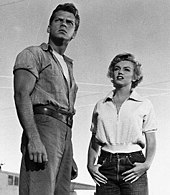
Keith Andes and Monroe in Clash by Night (1952). The film allowed Monroe to display more of her acting range in a dramatic role.
Despite her newfound popularity as a sex symbol, Monroe also wished to show more of her acting range. She had begun taking acting classes with Michael Chekhov and mime Lotte Goslar soon after beginning the Fox contract,[90] and Clash by Night and Don’t Bother to Knock showed her in more nuanced roles.[91] In the former, a drama starring Barbara Stanwyck and directed by Fritz Lang, she played a fish cannery worker; to prepare, she spent time in a fish cannery in Monterey.[92] She received positive reviews for her performance: The Hollywood Reporter stated that “she deserves starring status with her excellent interpretation”, and Variety wrote that she “has an ease of delivery which makes her a cinch for popularity”.[93][94] The latter was a thriller in which Monroe starred as a mentally disturbed babysitter and which Zanuck used to test her abilities in a heavier dramatic role.[95] It received mixed reviews from critics, with Crowther deeming her too inexperienced for the difficult role,[96] and Variety blaming the script for the film’s problems.[97][98]
Monroe’s three other films in 1952 continued with her typecasting in comic roles that focused on her sex appeal. In We’re Not Married!, her role as a beauty pageant contestant was created solely to “present Marilyn in two bathing suits”, according to its writer Nunnally Johnson.[99] In Howard Hawks‘ Monkey Business, in which she acted opposite Cary Grant, she played a secretary who is a “dumb, childish blonde, innocently unaware of the havoc her sexiness causes around her”.[100] In O. Henry’s Full House, she had a minor role as a sex worker.[100] Monroe added to her reputation as a new sex symbol with publicity stunts that year: she wore a revealing dress when acting as Grand Marshal at the Miss America Pageant parade, and told gossip columnist Earl Wilson that she usually wore no underwear.[101] By the end of the year, gossip columnist Florabel Muir named Monroe the “it girl” of 1952.[102]
During this period, Monroe gained a reputation for being difficult to work with, which would worsen as her career progressed. She was often late or did not show up at all, did not remember her lines, and would demand several re-takes before she was satisfied with her performance.[103] Her dependence on her acting coaches—Natasha Lytess and then Paula Strasberg—also irritated directors.[104] Monroe’s problems have been attributed to a combination of perfectionism, low self-esteem, and stage fright.[105] She disliked her lack of control on film sets and never experienced similar problems during photo shoots, in which she had more say over her performance and could be more spontaneous instead of following a script.[105][106] To alleviate her anxiety and chronic insomnia, she began to use barbiturates, amphetamines, and alcohol, which also exacerbated her problems, although she did not become severely addicted until 1956.[107] According to Sarah Churchwell, some of Monroe’s behavior, especially later in her career, was also in response to the condescension and sexism of her male co-stars and directors.[108] Similarly, biographer Lois Banner has stated that she was bullied by many of her directors.[109]
1953: Rising star
Monroe starred in three movies that were released in 1953 and emerged as a major sex symbol and one of Hollywood’s most bankable performers.[110][111] The first was the Technicolor film noir Niagara, in which she played a femme fatale scheming to murder her husband, played by Joseph Cotten.[112] By then, Monroe and her make-up artist Allan “Whitey” Snyder had developed her “trademark” make-up look: dark arched brows, pale skin, “glistening” red lips and a beauty mark.[113] According to Sarah Churchwell, Niagara was one of the most overtly sexual films of Monroe’s career.[100] In some scenes, Monroe’s body was covered only by a sheet or a towel, considered shocking by contemporary audiences.[114] Niagara’s most famous scene is a 30-second long shot behind Monroe where she is seen walking with her hips swaying, which was used heavily in the film’s marketing.[114]
When Niagara was released in January 1953, women’s clubs protested it as immoral, but it proved popular with audiences.[115] While Variety deemed it “clichéd” and “morbid”, The New York Times commented that “the falls and Miss Monroe are something to see”, as although Monroe may not be “the perfect actress at this point … she can be seductive—even when she walks”.[116][117] Monroe continued to attract attention by wearing revealing outfits, most famously at the Photoplay awards in January 1953, where she won the “Fastest Rising Star” award.[118] She wore a skin-tight gold lamé dress, which prompted veteran star Joan Crawford to publicly call her behavior “unbecoming an actress and a lady”.[118]
While Niagara made Monroe a sex symbol and established her “look”, her second film of 1953, the satirical musical comedy Gentlemen Prefer Blondes, cemented her screen persona as a “dumb blonde”.[119] Based on Anita Loos‘ novel and its Broadway version, the film focuses on two “gold-digging” showgirls played by Monroe and Jane Russell. Monroe’s role was originally intended for Betty Grable, who had been 20th Century-Fox’s most popular “blonde bombshell” in the 1940s; Monroe was fast eclipsing her as a star who could appeal to both male and female audiences.[120] As part of the film’s publicity campaign, she and Russell pressed their hand and footprints in wet concrete outside Grauman’s Chinese Theatre in June.[121] Gentlemen Prefer Blondes was released shortly after and became one of the biggest box office successes of the year.[122] Crowther of The New York Times and William Brogdon of Variety both commented favorably on Monroe, especially noting her performance of “Diamonds Are a Girl’s Best Friend“; according to the latter, she demonstrated the “ability to sex a song as well as point up the eye values of a scene by her presence”.[123][124]
In September, Monroe made her television debut in the Jack Benny Show, playing Jack’s fantasy woman in the episode “Honolulu Trip”.[125] She co-starred with Betty Grable and Lauren Bacall in her third movie of the year, How to Marry a Millionaire, released in November. It featured Monroe as a naïve model who teams up with her friends to find rich husbands, repeating the successful formula of Gentlemen Prefer Blondes. It was the second film ever released in CinemaScope, a widescreen format that Fox hoped would draw audiences back to theaters as television was beginning to cause losses to film studios.[126] Despite mixed reviews, the film was Monroe’s biggest box office success at that point in her career.[127]
Monroe was listed in the annual Top Ten Money Making Stars Poll in both 1953 and 1954,[111] and according to Fox historian Aubrey Solomon became the studio’s “greatest asset” alongside CinemaScope.[128] Monroe’s position as a leading sex symbol was confirmed in December 1953, when Hugh Hefner featured her on the cover and as centerfold in the first issue of Playboy; Monroe did not consent to the publication.[129] The cover image was a photograph taken of her at the Miss America Pageant parade in 1952, and the centerfold featured one of her 1949 nude photographs.[129]
1954–1955: Conflicts with 20th Century-Fox and marriage to Joe DiMaggio
Monroe had become one of 20th Century-Fox’s biggest stars, but her contract had not changed since 1950, meaning that she was paid far less than other stars of her stature and could not choose her projects.[130] Her attempts to appear in films that would not focus on her as a pin-up had been thwarted by the studio head executive, Darryll F. Zanuck, who had a strong personal dislike of her and did not think she would earn the studio as much revenue in other types of roles.[131] Under pressure from the studio’s owner, Spyros Skouras, Zanuck had also decided that Fox should focus exclusively on entertainment to maximize profits and canceled the production of any ‘serious films’.[132] In January 1954, he suspended Monroe when she refused to begin shooting yet another musical comedy, The Girl in Pink Tights.[133]
This was front-page news, and Monroe immediately took action to counter negative publicity. On January 14, she and Joe DiMaggio were married at the San Francisco City Hall.[134] They then traveled to Japan, combining a honeymoon with his business trip.[135] From Tokyo, she traveled alone to Korea, where she participated in a USO show, singing songs from her films for over 60,000 U.S. Marines over a four-day period.[136] After returning to the U.S., she was awarded Photoplay‘s “Most Popular Female Star” prize.[137] Monroe settled with Fox in March, with the promise of a new contract, a bonus of $100,000, and a starring role in the film adaptation of the Broadway success The Seven Year Itch.[138]
In April 1954, Otto Preminger‘s western River of No Return, the last film that Monroe had filmed prior to the suspension, was released. She called it a “Z-grade cowboy movie in which the acting finished second to the scenery and the CinemaScope process”, but it was popular with audiences.[139] The first film she made after the suspension was the musical There’s No Business Like Show Business, which she strongly disliked but the studio required her to do for dropping The Girl in Pink Tights.[138] It was unsuccessful upon its release in late 1954, with Monroe’s performance considered vulgar by many critics.[140]
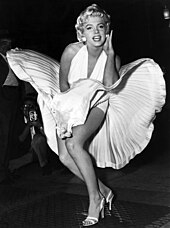
Posing for photographers while filming the subway grate scene in Manhattan for The Seven Year Itch
In September 1954, Monroe began filming Billy Wilder‘s comedy The Seven Year Itch, starring opposite Tom Ewell as a woman who becomes the object of her married neighbor’s sexual fantasies. Although the film was shot in Hollywood, the studio decided to generate advance publicity by staging the filming of a scene in which Monroe is standing on a subway grate with the air blowing up the skirt of her white dress on Lexington Avenue in Manhattan.[141] The shoot lasted for several hours and attracted nearly 2,000 spectators.[141] The “subway grate scene” became one of Monroe’s most famous and The Seven Year Itch became one of the biggest commercial successes of the year after its release in June 1955.[142]
The publicity stunt placed Monroe on international front pages, and it also marked the end of her marriage to DiMaggio, who was infuriated by it.[143] The union had been troubled from the start by his jealousy and controlling attitude; he was also physically abusive.[144] After returning from NYC to Hollywood in October 1954, Monroe filed for divorce, after only nine months of marriage.[145]
After filming for The Seven Year Itch wrapped up in November 1954, Monroe left Hollywood for the East Coast, where she and photographer Milton Greene founded their own production company, Marilyn Monroe Productions (MMP)—an action that has later been called “instrumental” in the collapse of the studio system.[146][e] Monroe stated that she was “tired of the same old sex roles” and asserted that she was no longer under contract to Fox, as it had not fulfilled its duties, such as paying her the promised bonus.[148] This began a year-long legal battle between her and Fox in January 1955.[149] The press largely ridiculed Monroe and she was parodied in the Broadway play Will Success Spoil Rock Hunter? (1955), in which her lookalike Jayne Mansfield played a dumb actress who starts her own production company.[150]
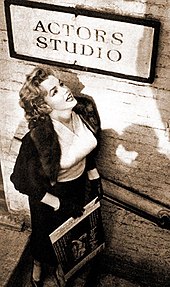
Monroe at the Actors Studio
After founding MMP, Monroe moved to Manhattan and spent 1955 studying acting. She took classes with Constance Collier and attended workshops on method acting at the Actors Studio, run by Lee Strasberg.[151] She grew close to Strasberg and his wife Paula, receiving private lessons at their home due to her shyness, and soon became a family member.[152] She replaced her old acting coach, Natasha Lytess, with Paula; the Strasbergs remained an important influence for the rest of her career.[153] Monroe also started undergoing psychoanalysis, as Strasberg believed that an actor must confront their emotional traumas and use them in their performances.[154][f]
Monroe continued her relationship with DiMaggio despite the ongoing divorce process; she also dated actor Marlon Brando and playwright Arthur Miller.[156] She had first been introduced to Miller by Elia Kazan in the early 1950s.[156] The affair between Monroe and Miller became increasingly serious after October 1955, when her divorce was finalized and he separated from his wife.[157] The studio urged her to end it, as Miller was being investigated by the FBI for allegations of communism and had been subpoenaed by the House Un-American Activities Committee, but Monroe refused.[158] The relationship led to FBI opening a file on her.[157]
By the end of the year, Monroe and Fox signed a new seven-year contract, as MMP would not be able to finance films alone, and the studio was eager to have Monroe working for them again.[149] Fox would pay her $400,000 to make four films, and granted her the right to choose her own projects, directors and cinematographers.[159] She would also be free to make one film with MMP per each completed film for Fox.[159]
1956–1959: Critical acclaim and marriage to Arthur Miller

Monroe’s dramatic performance in Bus Stop (1956) marked a departure from her earlier comedies.
Monroe began 1956 by announcing her win over 20th Century-Fox.[160] The press now wrote favorably about her decision to fight the studio; Time called her a “shrewd businesswoman”[161] and Look predicted that the win would be “an example of the individual against the herd for years to come”.[160] In contrast, Monroe’s relationship with Miller prompted some negative comments, such as Walter Winchell‘s statement that “America’s best-known blonde moving picture star is now the darling of the left-wing intelligentsia.”[162]
In March, Monroe began filming the drama Bus Stop, her first film under the new contract.[163] She played Chérie, a saloon singer whose dreams of stardom are complicated by a naïve cowboy who falls in love with her. For the role, she learned an Ozark accent, chose costumes and make-up that lacked the glamour of her earlier films, and provided deliberately mediocre singing and dancing.[164] Broadway director Joshua Logan agreed to direct, despite initially doubting her acting abilities and knowing of her reputation for being difficult.[165] The filming took place in Idaho and Arizona, with Monroe “technically in charge” as the head of MMP, occasionally making decisions on cinematography and with Logan adapting to her chronic lateness and perfectionism.[166] The experience changed Logan’s opinion of Monroe, and he later compared her to Charlie Chaplin in her ability to blend comedy and tragedy.[167]
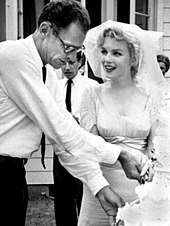
Arthur Miller and Monroe at their wedding in June 1956
On June 29, Monroe and Miller were married at the Westchester County Court in White Plains, New York; two days later they had a Jewish ceremony at the home of Kay Brown, Miller’s literary agent, in Waccabuc, New York.[168][169] With the marriage, Monroe converted to Judaism, which led Egypt to ban all of her films.[170][g] Due to Monroe’s status as a sex symbol and Miller’s image as an intellectual, the media saw the union as a mismatch, as evidenced by Variety‘s headline, “Egghead Weds Hourglass”.[172]
Bus Stop was released in August 1956 and became critical and commercial success.[173] The Saturday Review of Literature wrote that Monroe’s performance “effectively dispels once and for all the notion that she is merely a glamour personality” and Crowther proclaimed: “Hold on to your chairs, everybody, and get set for a rattling surprise. Marilyn Monroe has finally proved herself an actress.”[174] She also received a Golden Globe for Best Actress nomination for her performance.[83]
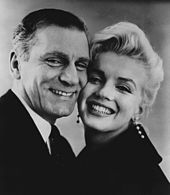
Laurence Olivier and Monroe during a press conference to announce their joint project, The Prince and the Showgirl (1957)
In August, Monroe also began filming MMP’s first independent production, The Prince and the Showgirl, at Pinewood Studios in England.[175] Based on a play about an affair between a showgirl and a prince in the 1910s, it was to be directed, co-produced and co-starred by Laurence Olivier.[161] The production was complicated by conflicts between him and Monroe.[176] He angered her with the patronizing statement “All you have to do is be sexy” and his attempts to get her to replicate Vivien Leigh‘s interpretation of the character in the stage version.[177] He also disliked the constant presence of Paula Strasberg, Monroe’s acting coach, on set.[178] In retaliation, Monroe became uncooperative and began to deliberately arrive late, stating later that “if you don’t respect your artists, they can’t work well.”[176]
Monroe also experienced other problems during the production. Her dependence on pharmaceuticals escalated and, according to Spoto, she had a miscarriage.[179] She and Greene also argued over how MMP should be run.[179] Despite the difficulties, filming was completed on schedule by the end of 1956.[180] The Prince and the Showgirl was released to mixed reviews in June 1957 and proved unpopular with American audiences.[181] It was better received in Europe, where she was awarded the Italian David di Donatello and the French Crystal Star awards and was nominated for a BAFTA.[182]
After returning from England, Monroe took an 18-month hiatus to concentrate on family life. She and Miller split their time between NYC, Connecticut and Long Island.[183] She had an ectopic pregnancy in mid-1957, and a miscarriage a year later;[184] these problems were most likely linked to her endometriosis.[185][h] Monroe was also briefly hospitalized due to a barbiturate overdose.[188] As she and Greene could not settle their disagreements over MMP, Monroe bought his share of the company.[189]

With Tony Curtis and Jack Lemmon in Billy Wilder‘s Some Like It Hot (1959), for which she won a Golden Globe
Monroe returned to Hollywood in July 1958 to act opposite Jack Lemmon and Tony Curtis in Billy Wilder’s comedy on gender roles, Some Like It Hot.[190] She considered the role of Sugar Kane another “dumb blonde”, but accepted it due to Miller’s encouragement and the offer of ten percent of the film’s profits on top of her standard pay.[191] The film’s difficult production has since become “legendary”.[192] Monroe demanded dozens of re-takes, and did not remember her lines or act as directed—Curtis famously stated that kissing her was “like kissing Hitler” due to the number of re-takes.[193] Monroe herself privately likened the production to a sinking ship and commented on her co-stars and director saying “[but] why should I worry, I have no phallic symbol to lose.”[194] Many of the problems stemmed from her and Wilder—who also had a reputation for being difficult—disagreeing on how she should play the role.[195] She angered him by asking to alter many of her scenes, which in turn made her stage fright worse, and it is suggested that she deliberately ruined several scenes to act them her way.[195]
In the end, Wilder was happy with Monroe’s performance and stated: “Anyone can remember lines, but it takes a real artist to come on the set and not know her lines and yet give the performance she did!”[196] Some Like It Hot became a critical and commercial success when it was released in March 1959.[197] Monroe’s performance earned her a Golden Globe for Best Actress, and prompted Variety to call her “a comedienne with that combination of sex appeal and timing that just can’t be beat”.[182][198] It has been voted one of the best films ever made in polls by the BBC,[199] the American Film Institute,[200] and Sight & Sound.[201]
1960–1962: Career decline and personal difficulties

Yves Montand and Monroe in the musical comedy Let’s Make Love (1960), which she agreed to make only to fulfill her contract with Fox
After Some Like It Hot, Monroe took another hiatus until late 1959, when she starred in the musical comedy Let’s Make Love.[202] She chose George Cukor to direct and Miller re-wrote some of the script, which she considered weak; she accepted the part solely because she was behind on her contract with Fox.[203] The film’s production was delayed by her frequent absences from the set.[202] During the shoot, Monroe had an extramarital affair with her co-star Yves Montand, which was widely reported by the press and used in the film’s publicity campaign.[204] Let’s Make Love was unsuccessful upon its release in September 1960;[205] Crowther described Monroe as appearing “rather untidy” and “lacking … the old Monroe dynamism”,[206] and Hedda Hopper called the film “the most vulgar picture [Monroe’s] ever done”.[207] Truman Capote lobbied for Monroe to play Holly Golightly in a film adaptation of Breakfast at Tiffany’s, but the role went to Audrey Hepburn as its producers feared that she would complicate the production.[208]
The last film that Monroe completed was John Huston’s The Misfits, which Miller had written to provide her with a dramatic role.[209] She played a recently divorced woman who becomes friends with three aging cowboys, played by Clark Gable, Eli Wallach and Montgomery Clift. The filming in the Nevada desert between July and November 1960 was again difficult.[210] Monroe and Miller’s marriage was effectively over, and he began a new relationship with set photographer Inge Morath.[209] Monroe disliked that he had based her role partly on her life, and thought it inferior to the male roles; she also struggled with Miller’s habit of re-writing scenes the night before filming.[211] Her health was also failing: she was in pain from gallstones, and her drug addiction was so severe that her make-up usually had to be applied while she was still asleep under the influence of barbiturates.[212] In August, filming was halted for her to spend a week in a hospital detox.[212] Despite her problems, Huston stated that when Monroe was acting, she “was not pretending to an emotion. It was the real thing. She would go deep down within herself and find it and bring it up into consciousness.”[213]
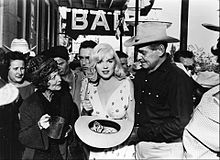
Estelle Winwood, Eli Wallach, Montgomery Clift, Monroe, and Clark Gable in The Misfits (1961). It was the last completed film for Monroe and Gable, who both died within two years.
Monroe and Miller separated after filming wrapped, and she obtained a Mexican divorce in January 1961.[214] The Misfits was released the following month, failing at the box office.[215] Its reviews were mixed,[215] with Variety complaining of frequently “choppy” character development,[216] and Bosley Crowther calling Monroe “completely blank and unfathomable” and stating that “unfortunately for the film’s structure, everything turns upon her”.[217] It has received more favorable reviews in the twenty-first century. Geoff Andrew of the British Film Institute has called it a classic,[218] Huston scholar Tony Tracy has described Monroe’s performance the “most mature interpretation of her career”,[219] and Geoffrey McNab of The Independent has praised her for being “extraordinary” in portraying the character’s “power of empathy”.[220]
Monroe was next to star in a television adaptation of W. Somerset Maugham‘s Rain for NBC, but the project fell through as the network did not want to hire her choice of director, Lee Strasberg.[221] Instead of working, she spent the first six months of 1961 preoccupied by health problems. She underwent a cholecystectomy and surgery for her endometriosis, and spent four weeks hospitalized for depression.[222][i] She was helped by ex-husband Joe DiMaggio, with whom she rekindled a friendship, and dated his friend, Frank Sinatra, for several months.[224] Monroe also moved permanently back to California in 1961, purchasing a house at 12305 Fifth Helena Drive in Brentwood, Los Angeles in early 1962.[225]

Monroe on the set of Something’s Got to Give. She was absent for most of the production due to illness and was fired by Fox in June 1962, two months before her death
Monroe returned to the public eye in the spring of 1962; she received a “World Film Favorite” Golden Globe Award and began to shoot a film for Fox, Something’s Got to Give, a remake of My Favorite Wife (1940).[226] It was to be co-produced by MMP, directed by George Cukor and to co-star Dean Martin and Cyd Charisse.[227] Days before filming began, Monroe caught sinusitis; despite medical advice to postpone the production, Fox began it as planned in late April.[228] Monroe was too sick to work for the majority of the next six weeks, but despite confirmations by multiple doctors, the studio pressurized her by alleging publicly that she was faking it.[228] On May 19, she took a break to sing “Happy Birthday, Mr. President” on stage at President John F. Kennedy‘s early birthday celebration at Madison Square Garden in New York.[229] She drew attention with her costume: a beige, skintight dress covered in rhinestones, which made her appear nude.[229][j] Monroe’s trip to New York caused even more irritation for Fox executives, who had wanted her to cancel it.[231]
Monroe next filmed a scene for Something’s Got to Give in which she swam naked in a swimming pool.[232] To generate advance publicity, the press was invited to take photographs; these were later published in Life. This was the first time that a major star had posed nude at the height of their career.[233] When she was again on sick leave for several days, Fox decided that it could not afford to have another film running behind schedule when it was already struggling with the rising costs of Cleopatra (1963).[234] On June 7, Fox fired Monroe and sued her for $750,000 in damages.[235] She was replaced by Lee Remick, but after Martin refused to make the film with anyone other than Monroe, Fox sued him as well and shut down the production.[236] The studio blamed Monroe for the film’s demise and began spreading negative publicity about her, even alleging that she was mentally disturbed.[235]
Fox soon regretted its decision and re-opened negotiations with Monroe later in June; a settlement about a new contract, including re-commencing Something’s Got to Give and a starring role in the black comedy What a Way to Go! (1964), was reached later that summer.[237] She was also planning on starring in a biopic of Jean Harlow.[238] To repair her public image, Monroe engaged in several publicity ventures, including interviews for Life and Cosmopolitan and her first photo shoot for Vogue.[239] For Vogue, she and photographer Bert Stern collaborated for two series of photographs, one a standard fashion editorial and another of her posing nude, which were published posthumously with the title The Last Sitting.[240]
Death

Front page of the New York Mirror on August 6, 1962
During her final months, Monroe lived at 12305 5th Helena Drive in the Brentwood neighborhood of Los Angeles. Her housekeeper Eunice Murray was staying overnight at the home on the evening of August 4, 1962.[241] Murray awoke at 3:00 a.m. on August 5 and sensed that something was wrong. She saw light from under Monroe’s bedroom door, but was unable to get a response and found the door locked. Murray then called Monroe’s psychiatrist, Dr. Ralph Greenson, who arrived at the house shortly after and broke into the bedroom through a window to find Monroe dead in her bed.[241] Monroe’s physician, Dr. Hyman Engelberg, arrived at around 3:50 a.m.[241] and pronounced her dead at the scene. At 4:25 a.m., the LAPD was notified.[241]
Monroe died between 8:30 p.m. and 10:30 p.m. on August 4,[242] and the toxicology report showed that the cause of death was acute barbiturate poisoning. She had 8 mg% (milligrams per 100 milliliters of solution) chloral hydrate and 4.5 mg% of pentobarbital (Nembutal) in her blood, and 13 mg% of pentobarbital in her liver.[243] Empty medicine bottles were found next to her bed.[244] The possibility that Monroe had accidentally overdosed was ruled out because the dosages found in her body were several times over the lethal limit.[245]
The Los Angeles County Coroners Office was assisted in their investigation by the Los Angeles Suicide Prevention Team, who had expert knowledge on suicide.[244] Monroe’s doctors stated that she had been “prone to severe fears and frequent depressions” with “abrupt and unpredictable mood changes”, and had overdosed several times in the past, possibly intentionally.[245][246] Due to these facts and the lack of any indication of foul play, deputy coroner Thomas Noguchi classified her death as a probable suicide.[247]
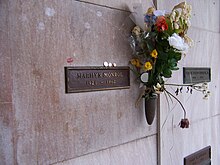
Monroe’s crypt at Westwood Memorial Park in Westwood Village
Monroe’s sudden death was front-page news in the United States and Europe.[248] According to Lois Banner, “it’s said that the suicide rate in Los Angeles doubled the month after she died; the circulation rate of most newspapers expanded that month”,[248] and the Chicago Tribune reported that they had received hundreds of phone calls from members of the public who were requesting information about her death.[249] French artist Jean Cocteau commented that her death “should serve as a terrible lesson to all those, whose chief occupation consists of spying on and tormenting film stars”, her former co-star Laurence Olivier deemed her “the complete victim of ballyhoo and sensation”, and Bus Stop director Joshua Logan stated that she was “one of the most unappreciated people in the world”.[250] Her funeral, held at the Westwood Village Memorial Park Cemetery on August 8, was private and attended by only her closest associates.[251] The service was arranged by Joe DiMaggio and Monroe’s business manager Inez Melson.[251] Hundreds of spectators crowded the streets around the cemetery.[251] Monroe was later entombed at Crypt No. 24 at the Corridor of Memories.[252]
In the following decades, several conspiracy theories, including murder and accidental overdose, have been introduced to contradict suicide as the cause of Monroe’s death.[253] The speculation that Monroe had been murdered first gained mainstream attention with the publication of Norman Mailer‘s Marilyn: A Biography in 1973, and in the following years became widespread enough for the Los Angeles County District Attorney John Van de Kamp to conduct a “threshold investigation” in 1982 to see whether a criminal investigation should be opened.[254] No evidence of foul play was found.[255]
Screen persona and reception

Jean Harlow was a platinum blonde 1930s film star who was a major inspiration for Monroe’s star image.
The 1940s had been the heyday for actresses who were perceived as tough and smart—such as Katharine Hepburn and Barbara Stanwyck—who had appealed to women-dominated audiences during the war years. 20th Century-Fox wanted Monroe to be a star of the new decade who would draw men to movie theaters, and saw her as a replacement for the aging Betty Grable, their most popular “blonde bombshell” of the 1940s.[256] According to film scholar Richard Dyer, Monroe’s star image was crafted mostly for the male gaze.[257]
From the beginning, Monroe played a significant part in the creation of her public image, and towards the end of her career exerted almost full control over it.[258][259] She devised many of her publicity strategies, cultivated friendships with gossip columnists such as Sidney Skolsky and Louella Parsons, and controlled the use of her images.[260] In addition to Grable, she was often compared to another iconic blonde, 1930s film star Jean Harlow.[261] The comparison was prompted partly by Monroe, who named Harlow as her childhood idol, wanted to play her in a biopic, and even employed Harlow’s hair stylist to color her hair.[262]
Monroe’s screen persona focused on her blonde hair and the stereotypes that were associated with it, especially dumbness, naïveté, sexual availability and artificiality.[263] She often used a breathy, childish voice in her films, and in interviews gave the impression that everything she said was “utterly innocent and uncalculated”, parodying herself with double entendres that came to be known as “Monroeisms”.[264] For example, when she was asked what she had on in the 1949 nude photo shoot, she replied, “I had the radio on”.[265]

Monroe portrayed a sexually attractive and naïve “dumb blonde” in Gentlemen Prefer Blondes (1953)
In her films, Monroe usually played “the girl”, who is defined solely by her gender.[257] Her roles were almost always chorus girls, secretaries, or models; occupations where “the woman is on show, there for the pleasure of men.”[257] Monroe began her career as a pin-up model, and was noted for her hourglass figure.[266] She was often positioned in film scenes so that her curvy silhouette was on display, and often posed like a pin-up in publicity photos.[266] Her distinctive, hip-swinging walk also drew attention to her body and earned her the nickname “the girl with the horizontal walk”.[100] Monroe often wore white to emphasize her blondness and drew attention by wearing revealing outfits that showed off her figure.[267] Her publicity stunts often revolved around her clothing either being shockingly revealing or even malfunctioning,[268] such as when a shoulder strap of her dress snapped during a press conference.[268]
In press stories, Monroe was portrayed as the embodiment of the American Dream, a girl who had risen from a miserable childhood to Hollywood stardom.[269] Stories of her time spent in foster families and an orphanage were exaggerated and even partly fabricated.[270] Film scholar Thomas Harris wrote that her working-class roots and lack of family made her appear more sexually available, “the ideal playmate”, in contrast to her contemporary, Grace Kelly, who was also marketed as an attractive blonde, but due to her upper-class background was seen as a sophisticated actress, unattainable for the majority of male viewers.[271]
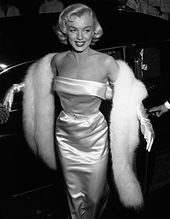
Monroe arriving at a party celebrating Louella Parsons at Ciro’s nightclub in May 1953
Although Monroe’s screen persona as a dim-witted but sexually attractive blonde was a carefully crafted act, audiences and film critics believed it to be her real personality. This became an obstacle when she wanted to pursue other kinds of roles, or to be respected as a businesswoman.[272] Academic Sarah Churchwell studied narratives about Monroe and has stated:
The biggest myth is that she was dumb. The second is that she was fragile. The third is that she couldn’t act. She was far from dumb, although she was not formally educated, and she was very sensitive about that. But she was very smart indeed—and very tough. She had to be both to beat the Hollywood studio system in the 1950s. […] The dumb blonde was a role—she was an actress, for heaven’s sake! Such a good actress that no one now believes she was anything but what she portrayed on screen.[273]
Biographer Lois Banner has written that Monroe often subtly parodied her status as a sex symbol in her films and public appearances,[274] and that “the ‘Marilyn Monroe’ character she created was a brilliant archetype, who stands between Mae West and Madonna in the tradition of twentieth-century gender tricksters.”[275] Monroe herself stated that she was influenced by West, learning “a few tricks from her—that impression of laughing at, or mocking, her own sexuality”.[276] She studied comedy in classes by mime and dancer Lotte Goslar, famous for her comic stage performances, and Goslar also instructed her on film sets.[277] In Gentlemen Prefer Blondes, one of the films in which she played an archetypal dumb blonde, Monroe had the sentence “I can be smart when it’s important, but most men don’t like it” added to her character’s lines.[278]
—Monroe in an interview for Life in 1962
According to Dyer, Monroe became “virtually a household name for sex” in the 1950s and “her image has to be situated in the flux of ideas about morality and sexuality that characterised the fifties in America”, such as Freudian ideas about sex, the Kinsey report (1953), and Betty Friedan‘s The Feminine Mystique (1963).[280] By appearing vulnerable and unaware of her sex appeal, Monroe was the first sex symbol to present sex as natural and without danger, in contrast to the 1940s femme fatales.[281] Spoto likewise describes her as the embodiment of “the postwar ideal of the American girl, soft, transparently needy, worshipful of men, naïve, offering sex without demands”, which is echoed in Molly Haskell‘s statement that “she was the fifties fiction, the lie that a woman had no sexual needs, that she is there to cater to, or enhance, a man’s needs.”[282] Monroe’s contemporary Norman Mailer wrote that “Marilyn suggested sex might be difficult and dangerous with others, but ice cream with her”, while Groucho Marx characterized her as “Mae West, Theda Bara, and Bo Peep all rolled into one”.[283] According to Haskell, due to her status as a sex symbol, Monroe was less popular with women than with men, as they “couldn’t identify with her and didn’t support her”, although this would change after her death.[284]
Dyer has also argued that Monroe’s blonde hair became her defining feature because it made her “racially unambiguous” and exclusively white just as the civil rights movement was beginning, and that she should be seen as emblematic of racism in twentieth-century popular culture.[285] Banner agreed that it may not be a coincidence that Monroe launched a trend of platinum blonde actresses during the civil rights movement, but has also criticized Dyer, pointing out that in her highly publicized private life, Monroe associated with people who were seen as “white ethnics“, such as Joe DiMaggio (Italian-American) and Arthur Miller (Jewish).[286] According to Banner, she sometimes challenged prevailing racial norms in her publicity photographs; for example, in an image featured in Look in 1951, she was shown in revealing clothes while practicing with African-American singing coach Phil Moore.[287]
Monroe was perceived as a specifically American star, “a national institution as well known as hot dogs, apple pie, or baseball” according to Photoplay.[288] Banner calls her the symbol of populuxe, a star whose joyful and glamorous public image “helped the nation cope with its paranoia in the 1950s about the Cold War, the atom bomb, and the totalitarian communist Soviet Union”.[289] Historian Fiona Handyside writes that the French female audiences associated whiteness/blondness with American modernity and cleanliness, and so Monroe came to symbolize a modern, “liberated” woman whose life takes place in the public sphere.[290] Film historian Laura Mulvey has written of her as an endorsement for American consumer culture:
If America was to export the democracy of glamour into post-war, impoverished Europe, the movies could be its shop window … Marilyn Monroe, with her all American attributes and streamlined sexuality, came to epitomise in a single image this complex interface of the economic, the political, and the erotic. By the mid 1950s, she stood for a brand of classless glamour, available to anyone using American cosmetics, nylons and peroxide.[291]
Twentieth Century-Fox further profited from Monroe’s popularity by cultivating several lookalike actresses, such as Jayne Mansfield and Sheree North.[292] Other studios also attempted to create their own Monroes: Universal Pictures with Mamie Van Doren,[293] Columbia Pictures with Kim Novak,[294] and Rank Organisation with Diana Dors.[295]
Legacy
According to The Guide to United States Popular Culture, “as an icon of American popular culture, Monroe’s few rivals in popularity include Elvis Presley and Mickey Mouse … no other star has ever inspired such a wide range of emotions—from lust to pity, from envy to remorse.”[296] Art historian Gail Levin stated that Monroe may have been “the most photographed person of the 20th century”,[297] and The American Film Institute has named her the sixth greatest female screen legend in American film history. The Smithsonian Institution has included her on their list of “100 Most Significant Americans of All Time”,[298] and both Variety and VH1 have placed her in the top ten in their rankings of the greatest popular culture icons of the twentieth century.[299][300]
Hundreds of books have been written about Monroe. She has been the subject of films, plays, operas, and songs, and has influenced artists and entertainers such as Andy Warhol and Madonna.[301][302] She also remains a valuable brand:[303] her image and name have been licensed for hundreds of products, and she has been featured in advertising for brands such as Max Factor, Chanel, Mercedes-Benz, and Absolut Vodka.[304][305]
Monroe’s enduring popularity is linked to her conflicted public image.[306] On the one hand, she remains a sex symbol, beauty icon and one of the most famous stars of classical Hollywood cinema.[307][308][309] On the other, she is also remembered for her troubled private life, unstable childhood, struggle for professional respect, as well as her death and the conspiracy theories that surrounded it.[310] She has been written about by scholars and journalists who are interested in gender and feminism;[311] these writers include Gloria Steinem, Jacqueline Rose,[312] Molly Haskell,[313] Sarah Churchwell,[305] and Lois Banner.[314] Some, such as Steinem, have viewed her as a victim of the studio system.[311][315] Others, such as Haskell,[316] Rose,[312] and Churchwell,[305] have instead stressed Monroe’s proactive role in her career and her participation in the creation of her public persona.

Left panel from pop artist James Gill‘s painting Marilyn Triptych (1962)
Due to the contrast between her stardom and troubled private life, Monroe is closely linked to broader discussions about modern phenomena such as mass media, fame, and consumer culture.[317] According to academic Susanne Hamscha, Monroe has continued relevance to ongoing discussions about modern society, and she is “never completely situated in one time or place” but has become “a surface on which narratives of American culture can be (re-)constructed”, and “functions as a cultural type that can be reproduced, transformed, translated into new contexts, and enacted by other people”.[317] Similarly, Banner has called Monroe the “eternal shapeshifter” who is re-created by “each generation, even each individual … to their own specifications”.[318]
Monroe remains a cultural icon, but critics are divided on her legacy as an actress. David Thomson called her body of work “insubstantial”[319] and Pauline Kael wrote that she could not act, but rather “used her lack of an actress’s skills to amuse the public. She had the wit or crassness or desperation to turn cheesecake into acting—and vice versa; she did what others had the ‘good taste’ not to do”.[320] In contrast, Peter Bradshaw wrote that Monroe was a talented comedian who “understood how comedy achieved its effects”,[321] and Roger Ebert wrote that “Monroe’s eccentricities and neuroses on sets became notorious, but studios put up with her long after any other actress would have been blackballed because what they got back on the screen was magical”.[322] Similarly, Jonathan Rosenbaum stated that “she subtly subverted the sexist content of her material” and that “the difficulty some people have discerning Monroe’s intelligence as an actress seems rooted in the ideology of a repressive era, when superfeminine women weren’t supposed to be smart”.[323]
Filmography
- Dangerous Years (1947)
- Scudda Hoo! Scudda Hay! (1948)
- Ladies of the Chorus (1948)
- Love Happy (1949)
- A Ticket to Tomahawk (1950)
- The Asphalt Jungle (1950)
- All About Eve (1950)
- The Fireball (1950)
- Right Cross (1951)
- Home Town Story (1951)
- As Young as You Feel (1951)
- Love Nest (1951)
- Let’s Make It Legal (1951)
- Clash by Night (1952)
- We’re Not Married! (1952)
- Don’t Bother to Knock (1952)
- Monkey Business (1952)
- O. Henry’s Full House (1952)
- Niagara (1953)
- Gentlemen Prefer Blondes (1953)
- How to Marry a Millionaire (1953)
- River of No Return (1954)
- There’s No Business Like Show Business (1954)
- The Seven Year Itch (1955)
- Bus Stop (1956)
- The Prince and the Showgirl (1957)
- Some Like It Hot (1959)
- Let’s Make Love (1960)
- The Misfits (1961)
- Something’s Got to Give (1962–unfinished)
ــــــــــــــــــــــــــــــــــــــــــــــــــــــــــــــــ
Marilyn Monroe – مارلين مونرو
| مارلين مونرو | |
|---|---|
| (بالإنجليزية: Marilyn Monroe) | |
|
|
|
| معلومات شخصية | |
| اسم الولادة | نورما جين مورتنصن |
| الميلاد | 1 يونيو 1926[1][2][3] لوس أنجلوس[4] |
| الوفاة | 5 أغسطس 1962 (36 سنة) Brentwood |
| سبب الوفاة | الجرعة الزائدة من الباربيتورات |
| مكان الدفن | مقبرة حديقة قرية ويستوود ميموريال |
| مواطنة | |
| لون الشعر | شعر أشقر |
| الطول | 168 سنتيمتر[5]، و165 سنتيمتر[5]، و65.5 بوصة[5] |
| الوزن | 60 كيلوغرام |
| الزوج | جيمس دوغيرتي (ز.1942-ط.1946) جو ديماجيو (ز.1954-ط.1955) أرثر ميلر (ز.1956-ط.1961) |
| الشريك | مارلون براندو (1955-1962) |
| الأب | Charles Stanley Gifford |
| الأم | Gladys Moore [6] |
| الحياة العملية | |
| الأدوار المهمة | كيف تتزوجين مليونيرا (1953) الرجال يفضلون الشقراوات (1953) نهر بلا عودة (1954) حكة السنة السابعة (1955) موقف الأوتوبيس (1956) الأمير وفتاة الاستعراض (1957) البعض يفضلونها ساخنة (1959) اللامنتمون (1961) دعنا نمارس الحب (1960) الألماس صديق الفتاة الوفي (1953) |
| المدرسة الأم | University High School مسرح لي ستراسبرغ ومعهد السينما جامعة كاليفورنيا، لوس أنجلوس (1951–) Van Nuys High School |
| تخصص أكاديمي | دراسات أدبية و فن |
| تعلمت لدى | لي ستراسبرغ، وكونستانس كولير |
| المهنة | ممثلة أفلام، وعارضة، ومنتجة أفلام، ومغنية، وكاتبة سير ذاتية، وبلاي ميت، وعارضة أزياء |
| اللغة الأم | إنجليزية أمريكية |
| اللغات | الإنجليزية[7] |
| الجوائز | |
|
جائزة هنريتا (1961)
جائزة غولدن غلوب لأفضل ممثلة – فيلم موسيقي أو كوميدي (عن عمل:البعض يفضلونها ساخنة) (1959) Targa d’Oro (عن عمل:The Prince and the Showgirl) (1958) ديفيد دي دوناتيلو |
|
| التوقيع | |
| المواقع | |
| الموقع | الموقع الرسمي |
| IMDB | صفحتها على IMDB |
| السينما.كوم | صفحتها على السينما.كوم |
ماريلين مونرو، أو نورما جين مورتنصن[8] كما سُميت عند مولدها (نورما جين باكير وفقاً لشهادة التعميد)[9]، وُلدت في الأول من يونيو 1926م في لوس أنجيلوس، وماتت بها في 5 أغسطس 1962، وهي ممثلة ومغنية أمريكية. كانت ستتجه في الأصل إلى مهنة عرض الأزياء، إلى أن وجدها هاورد هيوز وأقنعها بأن توقع عقدها الأول مع شركة أفلام فوكس للقرن العشرين في أغسطس 1946. واستطاعت في بداية الخمسينيات أن تصبح نجمة هوليودية ورمزاً جنسياً. شملت نجاحاتها الكبرى أفلام «الرجال يفضلون الشقراوات»، «سنة الحكة السابعة»، وأيضاً «البعض يفضلونها ساخنة»، والذي رشحها لجائزة الغولدن غلوب لأفضل ممثلة كوميدية في عام 1960م. ورغم تلك الشهرة المهولة، فقد فشلت مونرو في حياتها الشخصية، ولم تحقق لها مهنتها الرضا النفسي. وقد أثارت وفاتها العديد من الاحتمالات والظنون (انتحار، جرعة زائدة من المهدئات، أو اغتيال سياسي)، ما ساهم في تقوية مركزها كرمز ثقافي.
السيرة الذاتية
شجرة العائلة
وُلدت أم ماريلين، غلاديس بيرل مونرو (27 مايو 1902-11 مارس 1984[10]) في المكسيك لوالدين أمريكيين، وعملت في مجال الإخراج في مختبر صناعات الأفلام المدمجة (Consolidated Film Industries). تزوجت في 17 مايو 1917 من جون نيوتن «جاسبر» بايكر[11][12]، والذي أخذت مونرو اسم العائلة عنه في 1938. وقد أنجب الزوجان طفلين: روبرت كيرمت «جاك» (وُلد 24 يناير 1918) وبيرنيس إنيز غلاديس (وُلدت 30 يوليو 1919). جدير بالذكر أن غلاديس خاضت العديد من العلاقات العاطفية التي باءت بمشاكل نفسية وصحية، كما أن ماريلين لم تعرف أبداً هوية أبيها الحقيقي[13]. طالبت غلاديس بالطلاق في 20 يونيو 1921 بحجة الاضطهاد النفسي الوحشي[14]، ولكنها اتُهمت في المقابل بـ«السلوك غير اللائق والشهواني». أُعلن الطلاق 11 مايو 1923[15]، ونالت غلاديس حق حضانة الأطفال، ولكن دون الحق في رعايتهم بمسكنها، فقد أُجبرت على تركهم لوالدهم المقيم بولاية كنتاكي والذي تزوج مرةً أخرى. مات روبرت في 16 أغسطس 1933 في عمر الـ 16 سنة. أما بيرنيس، فلم تعاود الاتصال بأمها حتى 1939، حين كانت مقيمة بمستشفى آغنيوز لإصابتها بالشيزوفرنيا (وقد علمت حينها بأن لها أختاً غير شقيقة، نورما جين).
الطفولة والمراهقة
وُلدت ماريلين مونرو في الأول من يونيو 1926، في المستشفى العام بلوس أنجيلوس بكاليفورنيا[16]، حاملة اسم نورما جين مورتنصن[17][18]، وقد عُمدت تحت اسم نورما جين بايكر[10]). أعطتها أمها اسمها الأول[19] تيمناً بالفنانة نورما تالمادج. يظهر على شهادة الميلاد[17] أسماء الأم، غلاديس مونرو، وزوجها في ذلك الحين، مارتن إدوارد مورتنصن (1897-1981)[20][21]، رجل من كاليفورنيا ذات أصول نرويجية ويعمل في الكشف على عدادات الغاز. تزوج الطرفان في 11 أكتوبر 1924[22][23] ولكنهم انفصلوا في مايو 1925 (أي قبل ميلاد ماريلين بعام)؛ وحصل مورتنصن على قرار الطلاق في 15 أغسطس 1928 بحجة «هجر المنزل»[24]. ورغم أن ماريلين طفلة شرعية[21][25]، فإنها أنكرت طوال حياتها أن مورتنصن أبوها[20]. وحين كانت طفلة، أرتها أمها صورة فوتوغرافية لرجل كان يُعد والدها. وتتذكر مونرو أنه كان بشارب رفيع ويشبه بشكل ما كلارك غايبل[20][26]. لمدة طويلة للغاية، لم تتمكن غلاديس من الاحتفاظ ببنتها (وبقية أولادها) معها، وإنما عاشت ماريلين مع أسر أخرى[27]. وقد فضلت ماريلين لفترة طويلة أن تتظاهر بأن أمها قد ماتت بدلاً من الاعتراف بإقامتها في مؤسسة رعاية[28]. عاشت نورما جين (ماريلين) أول سبع سنين من عمرها مع ألبرت وإدا بولِندر، أقارب جدتها دِللا، هاوثورن بكاليفورنيا. في سيرتها الذاتية، تذكر ماريلين بأنها لم تعرف هوية «تلك السيدة حمراء الشعر» (أمها) التي تزورها من حين لأخر طوال تلك الفترة[29]. وفي 1933، عاشت بعض الوقت مع غلاديس التي استأجرت غرفة لدى عائلة آل أتكينسون، في شارع آربول بهوليوود، ولكن أُصيبت غلاديس بعدها بسنة بكارثة هيستيرية جديدة أدت لتحويلها للإقامة الداخلية بالمستشفى. في عام 1935، غراس ماكي، زميل غلاديس في الغرفة وفي العمل وأعز أصدقائها، طلب أن يصبح الوصي على ماريلين، وقد وُوفق على طلبه وصار وصياً بشكل رسمي في 27 مارس 1936[30]. في عام 1941، تعرف نورما جين على جارها جيمس «جيم» دوجيرتي، والذي كان أكبر منها بخمس سنوات، ويعمل في المصنع الأول للطائرات بلا طيار المُقادة بموجات الراديو التابع لشركة راديوبلاين (Radioplane Company)، والتي أنشأها الممثل ريجنالد ديني. نظم غراس الزواج والزفاف الذي أُجري في 19 يونيو 1942[31]، بعد بضعة أيام من عيد ميلادها السادس عشر. وبعد عام من الزواج، وبعد أن تركت دراستها، انضم جيم لأسطول تجاري، وبعدها في عام 1944 لطاقم ب-17 بألمانيا، قبل العودة للحياة المدنية في شرطة لوس أنجيلوس. عملت نورما جين في اختبار أجنحة الطائرات والمظلات في مصنع زوجها. وفي ذلك المصنع التقط المصورون العسكريون صورها[32]. ما روته ماريلين عن حياتها كزوجة لا يتطابق على الإطلاق مع التأكيدات التي قدمها جيم بعدها بفترة طويلة[33]. ففي حين أنها تقول إن الجنس لم يكن يهمها في ذلك السن وأنها تعاملت مع جيم على أنه أخوها الكبير، يحكي جيم بأنه أقام معها علاقات جنسية[33].
العمل في عرض الأزياء وخطواتها الأولى نحو السينما
في عام 1944، قابلت للمرة الأولى أختها غير الشقيقة بيرنيس بايكر ميراكل، بولاية تينيسي، أما أخوها غير الشقيق، هيرميت جاك، فقد مات قبلها بوقت سابق. التُقطت صورة نورما جين شبه-الاحترافية الأولى في خريف 1944 عن طريق المصور ديفيد كونوفر في إطار حملة الجيش الأمريكي لتوضيح مشاركة النساء في جهود الحرب. وفي بضعة شهور، احتلت مونرو غلاف ثلاثين مجلة إغرائية فبدأت تُعرف بـ «Mmmmm girl»[34]. تركت عملها كي تركز على عرض الأزياء، خاصة مع وكالة الكتاب الأزرق لعرض الأزياء (Blue Book Modeling). وفي ديسمبر 1945، أجرت أول اختبار تمثيل للوكالة، بهدف الدعاية لملابس سباحة. في فبراير 1946، صبغت شعرها من أجل حملة لنوع من أنواع الشامبو[35]. طلقت جيم في 2 أكتوبر 1946[36]، والذي لم يكن بينهما علاقة قوية نظراً لبعدهما عن بعضهما البعض. في سبيل تحقيق أحلامها السينمائية، أخذت مونرو دورات في المسرح، واستمرت في صبغ شعرها باللون الأشقر، ورسم حسنتها الشهيرة بالقلم، حيناً على ذقنها، وحيناً أخر على خدها الأيسر فوق الشفاه كي تخفي بقعة على وجهها[35]. أثارت نورما جين اهتمام بين ليون، الممثل الأمريكي ومدير الاستوديو بشركة أفلام فوكس للقرن العشرين، والذي أجرى لها اختباراً. وحين انبهر بأدائها أعلن: «ها هي جين هارلو الجديدة[37]». وقعت مع شركة فوكس عقدها الأول لمدة 6 شهور في 26 يولي 1946، في مقابل أجر بـ 125 دولار في الأسبوع. واتفقت مع الاستوديو على أن تغير اسمها لماريلين مونرو، وقد استلهمت اسم ماريلين من الممثلة ماريلين ميللر، والاسم مونرو من أمها[38] (تبنت الاسم رسمياً في 23 فبراير 1956[8]). كان ظهورها الأول على الشاشة عام 1947 في فيلمي «شجار على شقراء» و«أعوام خطرة». وفي عام 1948، وقعت عقداً جديدة مع شركة كولومبيا لمدة 6 أشهر[39]، وتوجهت نحو فيلم موسيقي بميزانية صغيرة «ملكات قاعة الموسيقى»، ولكن الفيلم قد فشل، ما نتج عنه عدم تجديد العقد[40]. أثار ظهورها في فيلم «صيد الكنز» مع الأخوة ماركس انبهار المنتجين، الذين بعثوها لنيويورك من أجل الترويج للفيلم[41]. كما أثارت انتباه جون هايد، وكيل في وكالة ويليام موريس، والذي قبل أن يمثلها ويصبح حبيبها[42]. حصل لها على دور في «حين تنام المدينة» لجون هيوست. ركزت الانتقادات الموجهة للفيلم على جودة أدائها[41]. وقد كان تنقصها الأموال في فترة من الفترات، ما اضطرها -تحت اسم مانا مونرو- على الموافقة في أن تُصور عارية عن طريق المصور توم كيللي من أجل طباعتها في تقويم، وقد دارت تلك الصور حول العام حين أصبحت مشهورة. لاحظها المخرج جوزيف إل. مانكيفيتس، الذي رأى فيها «موهبة كبيرة»[43]، وقد أشركها الأخير في فيلم «حواء» (1950) بجانب الممثل بيتي ديفيس. معتمدةً على نجاحاتها السابقة، فاوضت ماريلين على عقد بسبع سنوات مع شركة أفلام فوكس للقرن العشرين في ديسمبر 1950[44]. في سبتمبر، مجلة فوتوبلاي (Photoplay Magazine) كتبت عنها المقالة الأولى: «How a star is born?» (كيف تولد النجمة؟)، وكان المقال يلمح لفيلم «نجمةٌ قد وُلدت» لويليام آي. ويللمان (1937). في السنة اللاحقة، سجلت ماريلين في جامعة كاليفورنيا بلوس أنجيلوس حيث درست الأدب والفنون[45]، وظهرت في عدة أفلام صغيرة كشريكة لممثلين مثل: ميكي روني، كونستانس بينيت، جون أليسون، ديك باويل، وكلوديت كولبرت[46]. لم تُرشح مطلقاً للأوسكار، ولكنها ظهرت في حفلة تكريم وحيدة في 29 مارس 1951، وكان بهدف منح جائزة أفضل صوت لتوماس تي. مولتون لفيلم «حواء»[47]. كانت تلك الأمسية كارثية عليها حين اكتشفت أن فستانها مقطوعStudio Magazine Spécial Oscars & Césars 2008, p. 8. قامت بأداء صوتي للمسلسل التلفزيوني المستوحى من قصص «Li’l Abner» المصورة، ولكن المشروع لم يصل لأرض الواقع[48].
التركيز على مهنة التمثيل
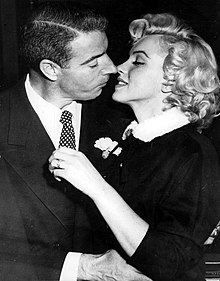
جو ديماجيو وماريلين مونرو بعد زواجهما في مركز مدينة سان فرانسيسكو، وقد انفصلا بعدها بـ 9 أشهر
في مارس 1952، أثارت ضجة كبيرة بظهورها عارية على تقويم ميلادي. تلك الحلقة من حياتها لم تلطخ سمعتها، بل أضافت شهرةً على شهرتها. أعلنت للصحفيين أنها قامت بذلك كي تتمكن من دفع الإيجار[49]. في 7 أبريل 1952، احتلت للمرة الأولى غلاف مجلة لايف (Life) حيث وُصفت بأنها «حديث هوليوود»[50]. وفي تلك اللحظة بدأت علاقتها العاطفية مع جو ديماجيو[51] أسطورة البيسبول الحية، الذي جاء حينها كي يعلن تقاعده. عملت في الشهور اللاحقة في 4 أفلام لشركة آر.كي.أو (RKO Pictures)، ونالت دوراً ثانياً في فيلم «الشيطان يستيقظ بالليل» لفريتز لانج مع باربرا ستانويك[52]. نزل الفيلم في يونيو 1952، وكان يُعد نجاحاً كبيراً على مستوى الجمهور والنقاد[53]. شاركت بعدها في فيلم الكوميديا «خمس محاولات زواج» والدراما «لا تنشغل بطرق الباب» حيث نالت الدور الرئيسي[54]. حيث يدور الفيلم عن ممرضة تهدد بأن تأخذ الطفل المسؤولة عنه. لم يستجب النقاد للفيلم، وقيمت فارايتي الفيلم على أنه «غير مهم»[55]. في فيلم «أعمال القردة»، حين ظهرت للمرة الأولى باللون الأشقر البلاتيني، لعبت دورها إلى جانب كاري جرانت وجرينجر روجرز تحت إخراج هاورد هوكس. حقق الفيلم نتيجة جيدة في شباك التذاكر رغم عدد من الانتقادات السلبية[56]. رأى داريل إف. زانوك فيها إمكانية تجارية هائلة، وأشكرها في فيلم «نياجرا» حيث لعبت دور امرأة مميتة تريد أن تقتل زوجها، والذي لعب دوره جوزيف كوتِّن[57]. قدر النقاد الفيلم واعتبروا التمثيل فيه «متفتح جنسياً»[57]. اعتبر الناقد كونستانس بيرنيت أن ماريلين «أمامها مستقبل كبير»[58]. أما الناقد زانوك فقد كان دائم الاحتقار لها، ولم يحرمها أبداً من معرفة ذلك[59]. وقد تبعته في ذلك الممثلة جوان كراوفورد، والتي وصفت ماريلين بـ«المبتذلة»[60]. صادقت ماريلين الممثلة جاين راسل في تصوير فيلم «الرجال يفضلون الشقراوات»، إخراج هاورد هوكس. وصفت راسل شريكتها بأنها «خجولة جداً، لطيفة جداً، وذكية جداً»[61]، وتلقت عن دورها في الفيلم السابق 400000 دولار[62]، بينما تلقت ماريلين 18000 دولار في الأسبوع[63]. في حين خروج الفيلم في لوس أنجيلوس في 26 يونيو 1953، طبعت الممثلتان بصماتن في أسمنت مسرح جرومان الصيني، بجانب رصيف الشهرة في شارع هوليوود[64]. وفي فيلمها اللاحق «كيف تتزوجي مليونير؟» (1953)، والذي شاركت فيه بيتي جرايبل ولورين بايكال، للمخرج جين نيجولسكو. كتبه نونالي جونسون، تدور القصة حول 3 عارضات أزياء من نيويورك تحاول كل واحدة منهم الزواج من مليونير. ساعدت أفلام تلك الفترة في زيادة شهرتها[65].
كشفت ماريلين لنيويورك تايمز شغفها بلعب الأدوار الدرامية[66]. عبرت عن رغبتها لشركة أفلام فوكس للقرن العشرين في المشاركة في فيلم مصري. عارض داريل إف. زانوك تلك الرغبة تماماً، حتى رفض إعطاءها فرصة للمحاولة[67]. وافقت على التمثيل بفيلم «نهر بلا عودة». لم تستمتع بالعمل مع المخرج أوتو برمنجر، حتى أنها رفضت أن تتحدث معه أثناء التصوير. واضطر شريكها روبرت ميتشم أن يلعب دور الوسيط بينهما[68]. وقالت فيما بعد أنها تستحق أفضل من فيلم من سلسلة Z لرعاة البقر[69]. في نهاية عام 1953، بدأت ماريلين تصوير فيلم «الفتاة ذات اللباس الوردي الضيق» مع فرانك سيناترا. وحين عبرت عن رفضها للتصوير، أوقفتها شركة فوكس عن العمل[70]. في 14 يناير 1954، تزوجت من جو ديماجيو، وأعلنت للصحافة أن: «هدفي الأساسي الآن هو التركيز على زواجي»[71]. في الشهر اللاحق أثناء صحبتها لزوجها في اليابان لتدريبه لفريق بيسبول هناك، عرض عليه الجيش الأمريكي أن يمضي 4 أيام في كوريا وأن يغني 3 أغان مقتبسة من أفلامه الأخيرة في 9 مناسبات، أمام جمهور من 60000 جندي أمريكي. سنحت له تلك التجربة الفرصة كي يتخطى خوفه من مواجهة الجمهور[72].
عادت إلى هوليوود في مارس 1954، وصفّت خلافاتها مع شركة فوكس، فعادت في فيلم غنائي «لا عمل مثل الاستعراض»، للمخرج والتر لانج، ولكن الفيلم قد أخفق[69]، واستقبله النقاد بشكل سلبي، حيث وصفوا أداء ماريلين بالـ«كارثي»[73] والـ«المحرج»[74]. كشفت ماريلين أنها لم تقبل الدور إلا على شريطة أن تمثل في فيلم أخر، وهو «حكة السنة السابعة»[75]. بدأت تصوير الفيلم في سبتمبر مع توم إويل. وفي نيويورك، لعبت مونرو أشهر أدوارها على مدار تاريخها الفني، وهو مرورها فوق شبكة المترو حيث رُفع فستانها الأبيض. أصر المخرج بيلي وايلدر أن يأخذ لقطات عديدة لذلك المشهد ما استفز جو ديماجيو[76]. وبعد خلافات عديدة، أعلنت ماريلين فراقها عن جو[77]، ووقع الطلاق في نوفمبر 1954[78]، بعد 8 شهور من الزواج. غادرت هوليوود سراً في 16 ديسمبر 1954 إلى نيويورك، عند منزل صديقها المصور ميلتون جرين، الذي أنشأت معه في 31 ديسمبر 1954 شركة ماريلين مونرو للإنتاج السينمائي (Marilyn Monroe Productions)، والتي طمحت أن تطلق من خلالها مهنتها الجديدة في نيويورك، أقنعها ميلتنون جرين أن تتحرر من الاستوديوهات الكبيرة التي تعطيها كبسولات ضارة وفقاً لمصادره. ونتيجة لتلك الرغبة في الاستقلال، أوقفت شركة فوكس عقدها رسمياً 15 يناير 1955[79].
أخذت دورات في الكوميديا عام 1955 مع الممثلة البريطانية كونستانس كوليه، وذلك بفضل ترومات كابوت. اعتبرت كوليه أن ماريلين تمتلك «موهبة جميلة، هشة ورقيقة»[80]. وبعد بضعة أسابيع من العمل، تبين أن أحد الممثلين بفيلم «الحبل» للمخرج ألفريد هيتشكوك مات في 21 مايو[80]، وبعد اجتماع مع شركة فوكس، طلبت ماريلين أن تعمل مع هيتشكوك. ولكن رد المخرج سريعاً على طلبها بالرفض، قائلاً بأنه لا يحب النساء «اللاتي يعلين الجنس على الشخصية»، وفضل الشقراوات الباردات مثل جرايس كيللي أو تيبي هيدرن[81]. أثناء تصوير «لا عمل مثل الاستعراض»، قابلت ماريلين بولا ستراسبرج وبنته سوزان. وطلبت أن تدرس باستوديو آكتورز (Actors’ Studio) مع لي ستراسبرج. في مارس 1955، قابلت مونرو شريل كرافورد، واحد من مؤسسي استوديو آكتورز، والذي قدمها للي ستراسبرج، والذي قبلها كتلميذة بعد مقابلتها[82]. في مايو، بدأت تترد على الكاتب المسرحي آرثر ميللر، والذي قابلته منذ خمسة أعوام[83]. وفي عيد ميلاد جو ديماجيو، في الأول من يونيو، اصطحب جو الكاتب آثر للعرض الأول لفيلم «حكة السنة السابعة» بنيويورك، ونظم حفلة صغيرة على شرفه. انتهت تلك الليلة بشجار علني قبل رحيل ماريلين المستعجل، ولم يرى بعضهما البعض لفترة طويلة[84][85]. استكملت دراساتها في استوديو آكتورز، وصارت هناك علاقة صداقة بينها وبين الممثلين كيفين ماكارثي وإلي والاش، والذي وصفها بأنها مولعة في دراستها وصادقة في هدفها[86]. لعبت دوراً في مسرحية آنا كريستي، مع مورين ستابلتون، المقتبسة عن رواية ليوجين أو نيل دون أن تنسى النص أثناء التمثيل، ولكن على النقيض من ذلك كانت تنسى في التكرارات التي فشلت فيها جميعاً[87]. أما آنا كريستي فقد لاقت نجاحاً كبيراً، وقد صفق الجمهور لماريلين[87]. ورغم أنها مجرد تلميذة، إلا أنها أكثر تلميذة يفتخر بها لي ستراسبرج («لقد عملت مع مئات الممثلين والممثلات، ولم يكن هناك إلا اثنين كانوا الأفضل من الباقي، الأول هو مارلون براندو، والثانية ماريلين مونرو»[87])، وقرر أن يأخذها تحت حمايته (كانت ماريلين تقيم في منزل عائلة ستاتبرج العائلي)، وحثها على أن تدرس التحليل النفسي كي تكون أقرب للشخصيات التي تؤدي دورها[79]. في ذلك الوقت، حقق «حكة السنة السابعة» نجاحاً كبيراً بمكسب يقارب الـ 8 مليون دولار من شباك التذاكر[88]، وأشاد النقاد بأداء مارلين. وبفضل ذلك النجاح، فاوضت ماريلين على عقد جديد مع شركة فوكس[88]، والذي أعطاها كم أكبر من القوة: 100000 دولار على الفيلم، 500 دولار بالأسبوع لتكاليف متعددة، حق رؤية السيناريو ومعرفة المخرج والمصور، وإمكانية العمل مع استوديوهات أخرى غير فوكس[89][90].
أول فيلم أُخرج في إطار العقد الجديد كان «موقف الأوتوبيس» للمخرج جوشوا لوجان، الذي وافق على طرق العمل مع النجمة[91]. أصبحت بولا ستراسبرج مستشارها الشخصي لكل أفلامها[92]. كانت زوجة لي هي التي تعرف آراء المخرجين جوشوا لوغان، لورنت أوليفيه، بيللي وايلدر، جورج كوكر، وجون هيوستن[93]. حتى أن بعد نهاية كل مشهد، كانت ماريلين تذهب إليها لمعرفة إن كان أداءها على مستوى آمالهم أم لا[94]. وبمجرد إيماءة من بولا وماريلين، كان يُعاد التصوير بالكامل، حتى ولو كان التصوير السابق يبدو مثالياً في أعين الجميع. مكروهة من الجميع، كانت بولا تُلقب بالـ «الفطر الأسود» أو «المشعوذة» من جانب التقنيين الذين لم تكن تحادثهم[94]. ورغم أن وجودها كان سخيفاً للكثيرين، فقد كانت تتواجد كي تطمئن مارلين[94]. في فيلم «موقف الأوتوبيس»، لعب دور «شيري»، مغنية ملهًا ليلي والتي تقع في حب راعي بقر. ونتيجة لرضا لوغان الشديد عن أدائها، حاول أن يجلب لها ترشيحاً للأوسكار كأفضل ممثلة[95][95]، ولكنها رُشحت بدلاً من ذلك لجائزة غولدن غلوب. مضت بعد ذلك مزيداً من الوقت مع آرثر ميللر، والذي تربطها به علاقة تمتد لأكثر من عام. في تلك اللحظة، بدأت الصحافة الكتابة عنهما[96]، ملقباً إياهما «رفيع الثقافة والحسناء»[97]، وقد تزوجا في 2 يونيو 1956.
وبعد فيلم «موقف الأتوبيس»، شاركت في فيلم أخر للمخرج لورنس أوليفيه «الأمير والراقصة». ولكن كره لورنس ماريلين بسبب نزواتها على خشبة المسرح[98]. في وقت لاحق، وصفها بأنها «رائعة، الأجمل من بين الجميع»[99]. لكن الفيلم فشل فشلاً ذريعاً، ورغم ذلك، فقد حياها النقاد، خاصةً الأوروبيين منهم، وفازت بجائزة ديفيد دي دوناتيللو، وجائزة كريستال ستار (Crystal Star Award) بفرنسا. كما رُشحت لجائزة الأكاديمية البريطانية للأفلام. غابت مارلين عن الشاشات في عام 1958، حيث عاشت مع زوجها آرثر في لونغ آيلند، وقامت بعملية إجهاض في الأول من أغسطس 1957[100][101]. شجعها زوجها على العودة لهوليوود للتمثيل في فيلم «البعض يحبونها ساخنة». رغم ذلك، كان المخرج يعلم بأنها مسبقاً متأخرة، وأن لديها رهبة المسرح، وواجهت صعوبات في محاولاتها لحفظ النص المطلوب في فيلم «حكة السنة السابعة»[102]. وفي تلك المرة، رفضت مارلين بشدة أن تصور عدة مشاهد من الفيلم[102][103]. كان تأخيرها المستمر عائد لصداقتها مع طوني كورتيس، الذي أعلن بعدها أن تقبيلها «مثل تقبيل هتلر»[104]. قال الممثل فيما بعد أن هذا مجرد مزاح[105]. وبسبب حملها في ذلك الوقت، قامت بعملية إجهاض أخرى في ديسمبر 1958، فور الانتهاء من الفيلم[106]. حقق فيلم «البعض يفضلونها ساخنة» نجاحاً مدوياً، حتى أنه رُشح لخمس جوائز أوسكار. حصلت ماريلين على جائزة غولدن غلوب لأفضل ممثلة عن فيلم موسيقى كوميدي عن أدائها. أعلن بيللي وايلدر أن الفيلم يُعد نجاحهما الأكبر[107]، بينما كانت مارلين دوماً كارهة له[108]. كان يستحضر أيضاً المشاكل التي واجهته أثناء تصوير الفيلم، حتى أنه قال «ماريلين كانت دوماً صعبة المراس لأنه كان من المستحيل التنبؤ بتصرفاتها. لم أكن أعرف في أي يوم نحن ذاهبة (…)، أهي متعاونة معنا أم معوقة لنا؟»[109]. مع ذلك فقد كان يحب مارلين، ويصفها بأنها ممثلة كوميدية وعبقرية[109]. واستحضر أيضاً مشروعات أخرى معها، من ضمنها «إيرما اللطيفة» مع شيرلي ماكلاين[110]. في الستينيات، وصلت ماريلين إلى قمة شهرتها. قبلت أن تمثل في فيلم «الملياردير» لجورج كوكر. ولكن نظراً لعدم رضائها بالسيناريو، فقد طالبت بأن يعيد زوجها، آرثر ميللر، كتابته[111]. كان الممثل جريجوري بيك سيقوم بالدور الذكوري الأول بالفيلم، ولكنه رفض بعد إطلاق النسخة الجديدة من السيناريو، وكذلك فعل كاري جرانت، شارلتون هستون، يَل برينار، وكذلك روك هدسون، وذلك قبل إناطة الدور لممثل غيره، إيف مونتاند[112]. كان التصوير صعباً للممثلة التي لم تتوافق في العمل مع المخرج، فقد كان للأخير -مثلي الجنس علناً-إعجاب بالممثل الفرنسي، والذي كان يربطها بنجمة الفيلم علاقة منتهية حين رفض مونتاند أن يهجر زوجته سيمون سيجنورت[113]. شكل الفيلم فشلاً نقدياً وتجارياً[114]. بدأت في تلك الفترة مشاكل مارلين الصحية. حيث بدأت في استشارة طبيباً نفسياً بلوس أنجيليس، الدكتور رالف غرينسن الذي رأته تقريباً كل أيام الأسبوع[115]. مارس الأخير تأثيرًا بالغًا على مريضته[115]. فوفقاً له، كانت علاقته الزوجية متوترة منذ فترة، بينما كان ميللر يقوم بكل ما بوسعه للحفاظ على علاقته بمارلين[116]. أعلن غرينسون أن هدفه الأساسي كان تقليل جرعة المخدرات التي تأخذها مارلين[117]. لعبت فيما بعد دوراً في فيلم «غير الأسوياء» لجون هوستون. كان الفيلم، الذي كتبه آرثر ميللر لزوجته جلب الممثلين كلارك غايبل، مونتجومري كليب، وإلي والاش. بدأ التصوير في يوليو 1960، ولكن بسبب غلبة المرض على مارلين، لم تستطع أن تؤد الدور، حتى أنها نُقلت للمستشفى لعشرة أيام[118]. دون مساعدة د. غرينسن، كانت تتناول الحبوب المنومة والكحوليات[117].. في 16 نوفمبر 1960، مات غايبل بسبب أزمة قلبية في لوس أنجيليس عن سن يراهن 59 سنة[119]. اتهم الصحفيون مارلين بوفاته بسبب تأخراتها المتكررة[108][120]. لم يحقق الفيلم نجاحاً تجارياً وكانت غالبية آراء النقاد سلبية تجاهه، بينما حيّا البعض الآخر أداء مونرو وغايبل[108][120]. خلال الشهور اللاحقة، صارت أكثر اعتماداً على الكحوليات والأدوية[121]. طلقت آرثر ميللر في يناير[121]، وكتبت وصيتها[122] في 14 يناير 1961. قبلت أن تكون محللتها النفسية ماريان ري كريس أن تجعلها تقيم بمصحة باين ويتني النفسية، ولكنها نُقلت لحجرة أمنية[79]. وصفت التجربة فيما بعد بأنها كـ«الكابوس»[123]. استغلت حقها في المكالمة الهاتفية كي تتصل بجو ديماجيو، والذي نقلها للمركز المفتوح بالمستشفى المشيخي بنيويورك حيث ظل بجانبها. وبعد 3 أسابيع من العلاج، خرجت من المستشفى، حيث لاحقها فوج من الصحفيين أثناء خروجها[124]. بسبب عدم قدرتها على التمثيل، عادت لكاليفورنيا كي تنال الراحة. وبعد تلك الإقامة الداخلية، طلبت من محاميها، ملتون رودين، أن يضيف تعديلاً على وصيتها، والذي أثار خلافاً ولم يُنفذ، وكان بخصوص «تعطيل نفوذ» الزوجين ستراسبرج، وماريان زي كريس[125].
العام 1962
وفقاً لعقدها المبرم مع شركة فوكس عام 1956[108]، فمارلين مازلت ملزمة بعمل فيلم أخير معها. أسند مديرو الاستوديو إلى أحد كاتبي السيناريو العاملين بها، آرنولد شولمان، إخراج طبعة جديدة من الفيلم الكوميدي «زوجتي المفضلة» (1940)، مع إيرين دان وكاري جرانت[108]. تدور القصة حول امرأة مختفية افتُرض وفاتها، والتي تدخل لمنزلها لتجد زوجها قد تزوج أخرى. اتُصل بالمخرج فرانك تاشلين، الذي عمل على أفلام جيري لويس الكوميدية، لإدارة الفيلم. ماريلين مونرو التي كانت تتوق للعودة للشاشة بفيلم مؤثر رفضت المشروع في المرة الأولى، وحكمت عليه بأنه «لا طعم له»[108]. مستفيدة من حق معرفة النص والمخرج، وافقت على إعادة التفكير في المشروع. وافقت الممثلة نونالي جونسون، والتي عملت مسبقاً في فيلم «كيف تتزوجين مليونيرًا؟»، على المشاركة في الفيلم. أما جورج كوكر الذي كان ملزماً أيضاً بأداء فيلم لشركة فوكس، فقد بدأ برفض المشروع؛ بسبب ذكرياته القبيحة من تصوير الفيلم السابق ذكره. نتيجة لتهديده بمقاضاته في حالة عدم الوفاء بالتزاماته، خضع جورج لهم ووافق على عرض الاستوديو (300000 دولار)، كي يجد مارلين التي يزدريها في وجهه مرة أخرى[108]. ووافقت مارلين على سيناريو فيلم آخر «شيء لابد من إعطائه»[126]. وفقًا لبنود العقد الجديد، الذي لا يربطها حصرياً بشركة فوكس، فهي ستربح دوماً 100000 دولار عن الفيلم، ما يُعد أقل بسبع مرات عن المعيار المعمول به حينها في هوليوود للنجوم الذين في نفس مرتبتها[126]. في سن الخامسة والثلاثن، اشترت منزلها الأول بقرض سكني، مقابل مبلغ قدره 35000 دولار. تُعد يونيس موراي -مدبرة منزلها الجديدة، وممرضها النفسية السابقة- هي التي وجدت لها المنزل بعنوان 12305، فيفث هيلينيا درايف (Fifth Helena Drive)، في برنتوود، في ضواحي لوس أنجيليس[126]. في 5 مارس 1962، ومن بعد حفلة الغولدن غلوب، أعطتها الصحافة الغربية للمرة الثانية جائزة النجمة السينما العالمية. وأثناء تلقيها الجائزة من روك هودسن، كان يصاحبها كاتب السيناريو جوزى بولانوس بسبب سكرها، ونالت الجائزة، وظلت تهذي بكلام غير واضح تشكر به الجمهور[127]. وحتى لا تُحرج، لم تُذاع الحفلة على الهواء[127].
في ذلك الوقت سلم نونالي جونسون سيناريو فيلم «شيء لابد من منحه» والذي وافقت عليه مارلين. ولكن نتيجة لعدم رضا جورج كوكر، طلب من صديقه والتر برنستن أن يعيد كتابة حواراته التي وصفها بأنها «خالية الروح»[127]. اشترك معه زملاؤه دين مارتن وسيد شارِس. في عشية بدء التصوير، والذي كان من المقرر عقده في 23 أبريل، أُصيبت مارلين بالبرد، وبلغت الاستوديو أنها لن تكون قادرة على الحضور[94].
بدأ كوكر تصوير كل المشاهد التي يظهر فيها بدونها[94]. وفي اليوم نفسه، ذهبت مارلين لتستشير الد.إنغلبرغ. شخص الطبيب حالة مارلين وتوصل لأنها مصابة بالتهاب الجيوب الأنفية المزمن، وأشار الطبيب الرسمي للاستوديو لي سييغل إلى ضرورة تأجيل التصوير مدة شهر واحد، ما رفضه الاستوديو[94]. في 30 أبريل، ظهرت مارلين للمرة الأولى للتمثيل، ومثلت 90 دقيقة من المشاهد السريعة، مخالفةً لتوجيهات الد. سييغل. نتج عن ذلك إصابتها بالغثيان المفاجئ، فإخلائها من الاستوديو[94]. عادت للتصوير بعد 3 أيام، في بداية شهر مايو، ومثلت أدوارها حول حمام السباحة[94]. استغلت مونرو راحة الإفطار، وغادرت مرة أخرى التصوير -رغم نهي الاستوديو- كي تحضر عيد ميلاد جون فيتزغيرالد كينيدي[128]، وفي أثناء غنائها «عيد ميلاد سعيد سيدي الرئيس»[129][130]، عارضت جاكي كينيدي -زوجة الرئيس- قدومها لحفلة زوجها الخاصة، وانسحبت بأطفالها ومضت إلى فيرجينيا[128]. عادت مونرو إلى هوليوود لتصوير مشاهدها التي سلبت أذهان رؤساء فوكس[131]. ورغم مرور عدة أيام دون مشاكل، فقد أصابتها عدة علامات على الهلع، ولم تكن قادرة على حفظ نصوصها، ما استفز كوكر الذي انتهى به الأمر لأن يستشيط غضباً في وجهها[131]. في الأول من يونيو، عيد ميلادها السادس والثلاثين، عادت إلى موقع التمثيل، حيث نُظمت لها حفلة على شرفها؛ وكان ذلك الظهور الرسمي الأخير لها[132]. حاولت فوكس أن تقدم إجابات للصحافة عن سر اختفائها، حيث قالوا بأنها قد طُردت وأنهم تواصلوا مع كيم نوفاك وكل الممثلات الأخريات من هوليوود وغيرهن لاستبدالها[59]. شرع الاستوديو ضد ماريلين وطالبها بـ 500000 دولار. وجه بيتر لِفاث -مدير الإنتاج بفوكس- إلى مونرو «نظام النجومية قد فقد السيطرة. لقد تركنا المجانين يديرون ملجأهم وقاموا بشبه-تدميره»[59]. غير أن كيم نوفاك وشيرلي ماكلاين أنكروا أن الدور قد عُرض عليهم من الأساس[59]. وفي النهاية، أعلن الاستوديو أخيراً اختياره للي رميك. عارض دين مارتن الاختيار ورفض استكمال التصوير دون مارلين. رفعت فوكس دعوة ضده وطالبته أيضاً بـ 500000 دولار لفسخ العقد[59]. عُلق طاقم الفريق لفترة قصيرة وتوقف عن العمل، وقاضى سيد تشاريس الممثل دين مارتن وطالبه بتعويضات قيمتها 14000 دولار عن الأضرار الناجمة عن خسارة الأرباح. وفي القضية المرفوعة ضد مارلين، رفع مديرو فوكس مبلغ التعويض المطلوب إلى 750000 دولار[59]. وفي 19 يونيو، رفعت فوكس دعوى أخرى ضد دين مارتن، حيث طالبوه بمبلغ 3,339,000 دولار[59]. في المقابل، رُفعت دعوى ضد فوكس، مطالبة إياها بـ 6,885,000 دولار. احتلت القضية الصفح الأولى من الجرائد، حتى أن بعض الجرائد اقتبست جملة الممثل: «لا مارلين، لا تمثيل!» («No Marilyn, no picture!»)[59]. ولكن الإجراءات قد توقفت بعدها بعام. بدأت المفاوضات على الفور. وفي 20 يونيو، أعلنت شركة فوكس استكمال التصوير قريبًا. أما ماريلين مونرو، ففي سبيل استعادة صورتها أمام الجمهور، استعانت بحملة علاقات عامة، حيث قام مصورون من الدرجة الأولى بتصويرها، وأدت حوارات صحفية مع مجلات كبيرة[133]. أعلنت هي وديماغيو عن أنهما سيتزوجان مجددًا، حتى أنهما حددا موعدًا لذلك، 8 أغسطس 1962. كما نوقشت مشاريع أفلام أخرى مثل «أنا أحب لويسا» و«قصة جين هارلو»[134]. أما خلافها مع شركة فوكس فقد حُل وجُدد العقد، وتقرر أن ينزل فيلم «شيء لابد من منحه» في بداية الخريف. وذهب إليها بيتر ليفاث لعقد جلسة صلح[133]. وبعد المقابلة، ضمنت ماريلين سيناريو جديداً، والتخلي عن كل الدعاوى القضائية المرفوعة ضدها، وطرد جورج كوكر رسمياً واستبداله بجين نيغيولسكو الذي أخرج «كيف تتزوجين مليونيرًا؟»، وأيضًا عقد جديد بمليون دولار على فيلمين: 250000 دولار لإنهاء «شيء لابد من منحه»، و750000 دولار لفيلم أخر سيتقرر في المستقبل[133][135]. وبلغت ماريلين مونرو من العمر 36 سنة، ووصل رصيد أفلامها إلى 30 فيلمًا. في نهاية يوليو، أُصيبت مونرو بالاكتئاب، وأسرّت إلى مصففة شعرها بأنها ستقوم بعملية إجهاض[136]. وفي آخر أسبوع من حياتها، حدد لها طبيبان -على الأقل- عدة وصفات بحبوب منومة في آخر أسبوع من حياتها[136]. في يوم الجمعة، 3 أغسطس، قامت ماريلين بالعديد من المكالمات الهاتفية المهنية والخاصة، وقابلت محللها النفسي وصديقتها بات نيوكومب[136]. وكان يوم السبت مماثلاً للجمعة، مكالمات هاتفية، وعمل في الحديقة مع الد. غرينسون، وتنزهت على الشاطئ مع الممثل بيتر لوفورد، شقيق كينيدي[136]. وصفتها بعض الشهادات بأنها كانت تحت تأثير المهدئات. في الساعة 7:45 مساءً، تواصلت هاتفياً مع لوفورد، حيث كانت مكتئبة ومضطربة[136]. اتصلت به مرة أخرى فيما بعد ولكن الخط كان مشوشًا. وأجرت بعدها العديد من المكالمات للمقربين منها كي يأتوا إليها. في النهاية، أتت إليها يونيس موراي -مدبرة المنزل- والتي بلغت د. غرينسون، بناءً على طلبه بأن كل شيء يسير على ما يرام، كانت الساعة 8:30 مساءً[136]. اعتبر دولاند سبوتو، مؤلف سيرة ماريلين الذاتية، أن ماريلين وقعت ضحية خطأ طبي[137]، ففي تلك اللحظة، كانت إما ماتت أو في الطريق لأن تموت بجرعة مفرطة من المهدئات. ماتت ماريلين في ليلة 4 أو 5 أغسطس. وقد مرت قرابة الخمس ساعات بين الوقت المقدر لوفاتها واتصال آل غرينسون الهاتفي، وأيضاً السيدة موراي ود. إنغلبرغ، بالشرطة. بعد البحث والتحري، كتب الطبيب الشرعي بلوس أنجيليس على ملفها: «انتحار محتمل»[138]. لم يتبين أبدًا السبب الحقيقي وراء وفاتها[136]، ومنذ 1962، كان احتمال مقتلها مثاراً، وكان يُتهم بذلك مكتب التحقيقات الفيدرالي ووكالة المخابرات المركزية[139]. وفي المشرحة، لم تستطع آغنس فلانغان (مصففة شعر جين هارلو التي صبغت شعرها بالأشقر البلاتيني الشهير) أن تعيد شعر ماريلين إلى حالته الطبيعية، فقد كان تالفاً للغاية نتيجة لسنين من العلاج (بيروكسيد من أجل الصبغة، والصودا الكاوية للتنعيم)، وأيضًا بسبب تشريح الجثة. أُلبست ماريلين باروكة تماثل التسريحة التي ظهرت بها في فيلمها الأخير «شيء لابد من منحه»، ما ولد الإشاعة أنها كانت ترتدي الباروكة طوال فترة التصوير، وكذلك أثناء تصوير «غير الأسوياء»[35]. دُفنت ماريلين في 8 أغسطس 1962 في مقبرة حديقة قرية وستوود التذكارية بلوس أنجيليس. نظمت أختها غير الشقيقة، بيرنيس ميراكل، بمساعدة جو ديماغيو، الجنازة التي لم يحضروها، ورغم اعتراضهما، فقد ظهر أصدقاؤها النجوم كدين مارتن وفرانك سيناترا[136]. ولشدة اضطراب زوج ماريلين السابق، مال إلى نعشها وهمس ثلاثاً بقوله: «أحبك»[136]. انتهت المراسم بلحن ماريلين المفضل «عبر قوس القزح» («Over the Rainbow») لجودي غارلاند[136].
الوفاة والشكوك التي تحوم حولها
 مقالة مفصلة: وفاة مارلين مونرو
مقالة مفصلة: وفاة مارلين مونرو
في 5 أغسطس 1962، حوالي الساعة الثالثة صباحاً، قلقت ربة المنزل، يونيس موراي، أن تكون ماريلين محبوسة في غرفتها، نظراً لأنها تركت النور مضاءً ولم تكن ترد على ندائاتها. بلغت المحلل النفسي رالف غرينسون، الذي أتى وكسر زجاج غرفتها للدخول، ثم اكتشف جثة الممثلة ملقاة على سريرها[140]، يدها على سماعة الهاتف، وبجانب المنضدة علب أقراص متناثرة، وعلى الأرض زجاجة فارغة من النيمبوتال[141]. اتصل غرينسون بهيمان إنغيلبرغ، الطبيب الشخصي لماريلين، والذي وصل حوالي الساعة 3:50 صباحاً، وأكد وفاتها رسميًا[142]. تلقى الضابط جاك كليمونز من قسم شرطة غرب لوس أنجيليس مكالمة هاتفية في الساعة 4:25 صباحًا من هيمان إنغلبرغ، والذي بلغه بانتحار الممثلة. كان كليمونز هو الشرطي الأول الذي وصل لمنزل النجمة في بنتوود[143]. تحدث تقرير الطبيب الشرعي توماس نوغوشي عن «انتحار محتمل» بسبب جرعة زائدة من الباربيتورات[138][144]. وبسبب نقص الأدلة، لم يستطع المتحرون لا أن يصنفوا الملف، ولا أن يؤكدوا إن كان انتحاراً أم اغتيالاً. ووفقاً لبعض الإشاعات، فقد كانت ماريلين ضحية لمؤامرة لمكتب التحقيقات الفيدرالي ووكالة المخابرات المركزية بهدف جمع أدلة تدين آل كينيدي[145]. ووفقاً لدون ولف، فقد اغتيلت ماريلين مونرو. وتتضمن روايته روبرت كينيدي ومجموعة من القريبين للممثلة الذين سيُقتلون في المستقبل[143]. وفقاً لدونالد سبوتو، ماتت ماريلين نتيجة لخطأ طبي[146]. فقد أُجري لها غسيل بهيدرات الكلورال (الكلورال الذي يسمح لها بالنوم)، رغم أنها امتصت قبلها نيمبوتال[146]، والمزج بين تلك المادتين قد يؤدي إلى الموت[146]. أُجريت الجنازة في 8 أغسطس 1962 في مقبرة وستوود التذكارية بلوس أنجيليس. نشرت جريدة لوس أنجيليس تايمز (Los Angeles Times) مقتطفات من محادثات ماريلين مع محللها النفسي، كما ذكرها محقق عن وفاتها، ذُكر فيها أن النجمة كانت تتساءل عن عملها، جسدها، زيجاتها. حصل المحقق المسؤول عن تلك القضية جون مينر على تسجيلات جلسات ماريلين على الأريكة، من المحلل النفسي د. رالف غرينسن، واستطاع أن يحصل على ملاحظات في غاية الكمال. في تلك الملاحظات، تظهر مارلين مهووسة بجوائز الأوسكار، وتتساءل حول طبيعة مهنتها، وتفكر جدياً في أداء عمل لويليام شيكسبير كي تؤخذ على محمل الجدية. حكت أيضاً لد. غرينسن كيف أنها تقف عارية أمام المرآة، لكي ترى آثار التقدم في العمر على جسدها، ولكي تجد أن «صدرها يتبلد قليلًا، [لكن] طولي مازال جيدًا، وردفاها مازالا في أفضل حال». تحدثت أيضًا عن كلارك غايبل، والذي أملت أن تجد فيه حبًا أبويًا، وتحدث عن زيجاتها وطلقاتها مع لاعب البيسبول جو ديماغيو والكاتب المسرحي آرثر ميللر.
وفقًا لجون مينر، الاستماع لتلك التسجيلات يوضح «أنه من المستحيل أن تكون تلك المرأة قد انتحرت. فقد كانت لديها مشروعات مستقبلية محددة بدقة، وكانت تعلم ما الذي تريد فعله. وقال لها لي ستراسبرج بأن تلعب دوراً لشيكسبير، وكانت مبهورة بتلك الفكرة». يرى المحقق أن ماريلين قد اغتيلت: بعد أن وُضع لها منوم في كوبها، وُضع لها نيمبوتال ذائب بالماء بكمية كبيرة، في شكل حقنة شرجية[147][148]. غير أن تأكيدات النائب العام مينر قد هوجمت بشدة من كثير من كاتبي السير الذاتية، كما أنها ناقضت العديد من الشهادات، منها شهادة النائب العام السبق وأرملة المحلل النفسي رالف غرنسن، والتي أكدت لجريدة لوس أنجيليس تايمز أن زوجها لم يكشف أبدًا عن وجود تلك التسجيلات[147].
الشهرة
رغم مرور خمسين عاماً على وفاتها. تظل ماريلين مونرو واحدة من أشهر الممثلات، وقد تناولتها الكثير من الوثائقيات وكتب السيرة الذاتية[149]، والعديد من الأفلام التلفزيونية قد تناولت مسيرة حياتها، مع الكثير من الممثلين الكوميديين كآشلي جود[150] أو بوبي مونتجمري[151]. وقد جسدتها مؤخراً شارلوت سولليفان في مسلسل «آل كينيدي»، وميشيل ويليامز في «أسبوعي مع ماريلين». كما أن صورتها قد استُعملت بشكل واسع على أغلفة المجلات، الإعلانات، المنتجات المشتقة كالماكياج[152]، وكذلك السينما[153] في أفلام كـ «Pulp Fiction»، «L.A.»، «Confidential»، وكذلك مسلسل عائلة سمبسون، حيث نرى مشهد المترو من فيلم «حكة السنة السابعة». وفي 2006، قامت نيكول كيدمان بالأداء الصوتي لشخصية نورما جين في فيلم الرسوم المتحركة «Happy Feet». كما عُرضت في أغان كثيرة مثل «شمعة في الرياح»، «الوداع يا طريق الطوب الأصفر» لإلتون جون، «موضة مادونا»، «بلاك ماريلين» لشيم أو «ماريلين مونرو» لفاريل ويليامز. في 2012، قدرت مجلة فوربس أن ماريلين تربح سنويًا 27 مليون دولار[154]. لذلك اعتُبرت كأكثر امرأة حققت أرباحاً في العالم. كنوع من المزاح، أورثت ماريلين حوالي 576 قطعة من ممتلكاتها للي ستراسبرغ (بيعت تلك القطع في مزاد علني بمنزل كريستي يومي 27 و28 أكتوبر 1999 بنيويورك) بهدف أن يوزعهم على دائرة معارفه، وبعد موت لي، انتقلت ملكية تلك القطع لزوجته، التي قررت في النهاية بيعهم. كان المكسب النهائي للمزاد، الذي قُدر مسبقًا فيما بين 10 و15 مليون دولار، يعادل 13.4 مليون دولار. كانت الممثلة أيضًا موضوعًا لسلسلة من اللوح الحريرية للفنان آندي وارهول في 1964[155]، وكانت واحدة من أعمال الفنان الأكثر إنتاجًا حينها. في 1967، تجمع عدد كبير من الفنانين ذوي توجه الـ«pop» في معرض «رثاء لماريلين مونرو» في معرض سيدني جانيس بنيويورك.
العري في مسيرتها الفنية
في مايو 1948، صور توم كيللي ماريلين عارية كي تُطبع صورتها على تقويم ميلادي (عُرف باسم تقويم الأحلام الذهبية)[156]. في 1952، ورغم تمتعها بشهرة مؤكدة، فقد كانت ضحية ابتزاز بكشف تلك الواقعة، فقررت ماريلين في النهاية أن تكشف تلك الواقعة، قائلةً أنها كانت بضائقة مادية واحتاجت للمال. في ديسمبر 1953، ظهرت بعض تلك الصور في العدد الأول من مجلة بلاي بوي، حيث أعاد الناشر هيو هيفنر شراء تلك الصور مقابل 500 دولار. انتشرت شائعة دون أساس من الصحة تخص ماريلين بمشاركتها في أفلام إباحية، منها فيلم يُدعى «تفاحات، مطارق، وزجاجة الكولا» (Apples, Knockers, and the Coke» «Bottle). عُرضت بعض الصور في مجلات إباحية بأنحاء العالم. في 1982، أثبتت مجلت بلاي بوي خطأ تلك الإشاعة، حيث ذكرت أن ممثلة الفيلم المذكور هي فتاة قديمة من 1954، آرلين هانتر، شقراء اشتركت مع ماريلين في بعض الملامح. في 2008، كشفت جريدة نيويورك بوست أن نسخة فيلم إباحي لماريلين أُخرجت في الخمسينيات بالأبيض والأسود، وقد اشتراها رجل أعمال من نيويورك مقابل 1.5 مليون دولار. في يونيو 1962، قبل وقت قليل من موتها، شاركت ماريلين مونرو في جلسة تصوير أخيرة[133]، سُميت فيما بعد بـ«الجلسة الأخيرة» (The Last Sitting)، حيث ظهرت فيها عارية الصدر. في تصويرها الأخير، الذي لم يرى النور، «شيء لابد من منحه» لجورج كوكر، تضمن الفيلم مشهد خالد للمصور لورنس شيللر في 23 مايو 1962، حيث ظهرت على سطح حمام سباحة عارية الظهر[157]. لفت تلك الصور حول أنحاء العالم.
الأجور
| العام | الفيلم | الأجر حين التوقيع/تجديد الأجر[156] |
|---|---|---|
| 1948 | شجار على شقراء | 75$/الأسبوع (600$/الأسبوع) |
| 1950 | حين تنام المدينة | 1050$ (9000$) |
| 1950 | حواء | 500$/الأسبوع (4000$/الأسبوع) |
| 1952 | لسنا متزوجين! | 750$/الأسبوع (6000$/الأسبوع) |
| 1953 | الرجال يفضلون الشقراوات | 1250$/الأسبوع (11000$/الأسبوع) |
| 1954 | لا عمل مثل عمل الاستعراض | 1000$/الأسبوع (8300$/الأسبوع) |
| 1955 | حكة السنة السابعة | 1500$/الأسبوع (12000$/الأسبوع) |
| 1959 | البعض يفضلونها ساخنة | 200000$ + 10% من الأرباح (1700000$) |
| 1961 | غير الأسوياء | 250000$ (210000$) |
| 1962 | شيء لابد من منحه | 10000$ (830000$) |
الحياة الخاصة
الزواج
تزوجت ماريلين 3 مرات على مدار حياتها:
- من 18 يونيو 1942 حتى 13 سبتمبر 1946، مع جيمس دوغيرتي[36].
- من 14 يناير 1954 حتى 27 أكتوبر 1954 مع جو ديماغيو[36].
- من 29 يونيو 1956 حتى 24 يناير 1961 مع آرثر ميللر[36].
تزوجت الأول حين كانت تبلغ من العمر 16 عاماً، وكان جيمس دوغيرتي يُلقب حينها بـ«جيم المحظوظ» لتزوجه بها[33]. كانت تلقبه بـ«دادي» (Daddy) وكان يلقبها بـ«بيبي» (Baby)[33]. في طفولتها، افتقدت ماريلين كل من حولها، وحين انضم جيمس للبحرية، انهارت وشعرت مرة أخرى بأنها هُجرت. قالت فيما بعد بأن ذلك الزواج لم يكن سعيدًا أو بائسًا[33]. لذلك لم يكن انفصالها عنه إلا مجرد شكليات[33]. أما جو ديماغيو، بطل البيسبول الأشهر في الخمسينيات، والمنحدر من أصول صقلية، فقد وقع في غرامها وطلق زوجته كي يتزوج ماريلين في 1954[158]. شغفت أمريكا كلها بقصة حبهما[158]. ولكن طغى حب ماريلين لعملها ولجمهورها على علاقتها الزوجية، ما أدى لدمارها بعد 9 أشهر[158]. وحتى إن كانا مازالا يحبان بعضهما البعض، فقد حرمتهما المحكمة بالحكم على جو بالاضطهاد النفسي[158]. كانت ماريلين بحاجة لأن تعشق شخصًا[159]، تلك هي حالة الكاتب آرثر ميللر الذي كان مولعًا بها[159]، . بعد زواجهما في 1956، غير الأخير رأيه فيها، ولم يتردد في حكي أسوأ الفظائع عنها[159]، ، فقد وصفها بأنها «وحش نرجسي وشرير قد أخذ طاقتي وسلبني من موهبتي»[159]، . اعتبرت ماريلين أنها وجدت السعادة والاستقرار بقربه، ولكن رغم جهودها (من ضمنها اعتناقها لليهودية[160][161][162])، انفصل الزوجان في 1961. وفي تصوير فيلم الملياردير، وقعت ماريلين في حب شريكها إيف مونتاند. أعلنت زوجته، سيمون سينوري أنه: «إذا كانت ماريلين تحب زوجي، فهذا دليل على حسن ذوقها»[158].انتهى الأمر بمونتاند بسأمه من مشاعر ماريلين الصادقة تجاهه، وعودته لسينيوري[158]. أما كلارك غايبل، فقد كان يُعد الرجل المثالي لماريلين، حيث أحبت أن تتخيل أنه كان مثل أبيها. وفي أثناء تصوير «غير الأسوياء»، تجاهل غايبل بكياسة حقيقة إعجاب ماريلين به[158].
علاقتها بآل كينيدي
في 19 مايو 1962، ظهرت ماريلين علنًا للمرة الأخيرة في مناسبة هامة، وقد كانت شبه مخمورة[163] أثناء غنائها «Happy Birthday, Mr. President» بمناسبة عيد ميلاد الرئيس جون فيتزغارد كينيدي في حديقة ماديسون سكوير. بيع فستانها الساحر الذي حضرت به الحفل مقابل 1.3 مليون دولار في المزاد العلني عام 1999[164]. وقد كان فستان ضيق من الحرير الوردي المرقط بـ 2500 كريستالة، وأصبح الفستان الأغلى في العالم، متجاوزًا فستان الأميرة ديانا الذي لبسته للرقص مع جون ترافولتا، وبيع مقابل 222500 دولار في يونيو 1997[164]. ومنذ الستينيات، كانت علاقات النجمة مع جون كينيدي وأخيه روبرت هدفاً للكثير من الإشاعات[165]. ولم تُؤكد تلك العلاقات إلا في 1970، بعد نشر فرانك كابل لكتاب «موت ماريلين مونرو الغريب» (The Strange Death of Marilyn Monroe)[165].. كما تبين أنه كان لجون كينيدي عشيقة أخرى، وهي جوديث كامبل، والتي ذكرت ذلك في مذكراتها الخاصة، المنشورة في عام 1977[165].
فيلموغرافيا
| Dangerous Years (1947) | Scudda Hoo! Scudda Hay! (1948) | Ladies of the Chorus (1948) |
| Love Happy (1949) | A Ticket to Tomahawk (1950) | The Asphalt Jungle (1950) |
| All About Eve (1950) | The Fireball (1950) | Right Cross (1951) |
| Home Town Story (1951) | As Young as You Feel (1951) | Love Nest (1951) |
| Let’s Make It Legal (1951) | Clash by Night (1952) | We’re Not Married! (1952) |
| Don’t Bother to Knock (1952) | Monkey Business (1952) | O. Henry’s Full House (1952) |
| Niagara (1953) | Gentlemen Prefer Blondes (1953) | How to Marry a Millionaire (1953) |
| River of No Return (1954) | There’s No Business Like Show Business (1954) | The Seven Year Itch (1955) |
| Bus Stop (1956) | The Prince and the Showgirl (1957) | Some Like It Hot (1959) |
| Let’s Make Love (1960) | The Misfits (1961) | Something’s Got to Give (1962) |
تكريمات

نجمة ماريلين مونرو في حي Walk of Fame بهوليوود
- تقرر أن «تُخَلَد» بصمات يديها وقدميها بفناء الشهرة بمسرح غرومان الصيني في 26 يونيو 1953، وكذلك في هولييد على ممر الشهرة، الذين يضم 2000 نجمة، بعنوان 6778 شارع هوليوود[166].
- في 1999، قرر معهد الفيلم الأمريكي تصنيفها كسادس أكبر ممثلة أمريكية عبر التاريخ في تصنيف AFI’s 100 Years… 100 stars[167][168][169][170].
- في 2009، نالت ماريلين مونرو المركز الأول في برنامج Film’s Sexiest Women of All Time (المرأة الأكثر جمالًا على مر الزمن)، على القناة الأمريكية TV Guide Network.
- لقب نيزك على اسمها في ذكراها، باسم (3768) Monroe.
الجوائز
- 1952: جائزة مخصوصة من مجلة Photoplay.
- 1953: النجمة الأنثى الأكثر شهرة لمجلة Photoplay.
- غولدن غلوب 1954: Henrietta Award[171].
- جائزة David di Donatello عام 1958: أفضل ممثلة أجنبية، عن فيلم «الأمير وفتاة الاستعراض».
- جائزة Étoile de cristal (نجم الكريستال) الفرنسية، عام 1959: أفضل ممثلة أجنبية، عن فيلم «الأمير وفتاة الاستعراض».
- غولدن غلوب 1960: أفضل ممثلة عن فيلم غنائي أو كوميدي، عن فيلم «البعض يفضلونها ساخنة».
- غولدن غلوب 1962: Henrietta Award
الترشيحات
- جائزة BAFTA لعام 1956: أفضل ممثلة أجنبية عن فيلم «حكة السنة السابعة».
- غولدن غلوب 1956: أفضل ممثلة عن فيلم غنائي أو كوميدي، عن فيلم «موقف الحافالات».
- جائزة BAFTA لعام 1958: أفضل ممثلة أجنبية عن فيلم «الأمير وفتاة الاستعراض».
أعمال مستوحاة عن الفنانة
الرسومات
عُرضت ماريلين في العديد من اللوحات الفنية والرسومات الشعبية، من ضمنها:
- ويليم دي كوننغ :Marilyn Monroe, 1954
- Douglas Kirkland : An evening with Marilyn
- جيمس جيل (رسام) :Marilyn Triptych, 1962
- James Rosenquist :Marilyn Monroe I, 1962
- Mimmo Rotella :Marilyn Monroe, 1962
- Wolf Vostell :Marilyn Monroe, 1962
- آندي وارهول :Marilyn Diptych, 1962
- ريتشارد هاميلتون (رسام) : My Marilyn, 1966
- سلفادور دالي :Mao Monroe, 1967
- Robert Rauschenberg :Test Stone #1, 1967
- جورج سيغال :The Film Poster, 1967
- ريتشارد ليندنر :Marilyn was here, 1970
- ريتشارد سيرا :Marilyn Monroe–Greta Garbo, 1981
- Gottfried Helnwein :Boulevard of Broken Dreams, 1984
- بيتر بليك (رسام) :Marilyn Monroe Wall No 2, 1990
- دوغلاس غوردون : As Kurt Cobain, as Andy Warhol, as Myra Hindley, as Marilyn Monroe, 1996
- ميل راموس :Peek-a-boo Marilyn, 200
المسرح
- من قتل مارلين؟ مسرحية لبنانية، تمثيل مروة خليل وريـّا حـيدر وإخراج نديم دعيبس[172]
- «بعد السقوط» لآرثر ميلر.





